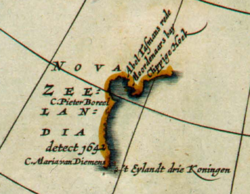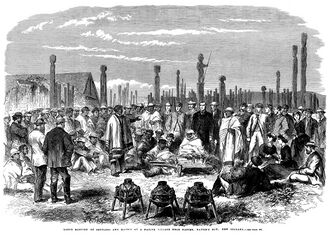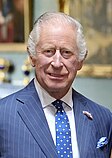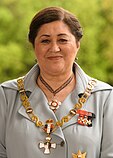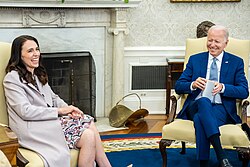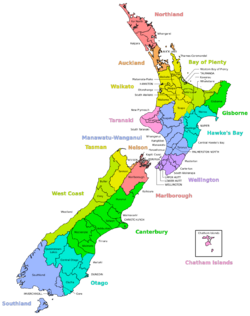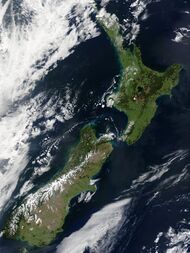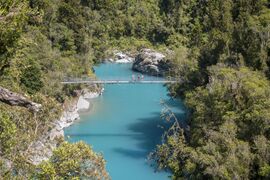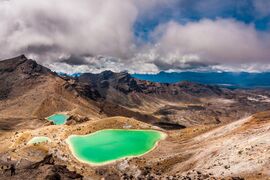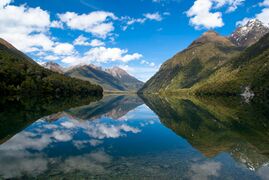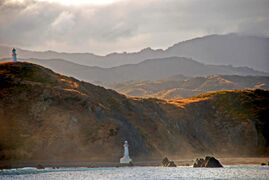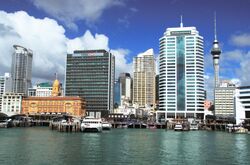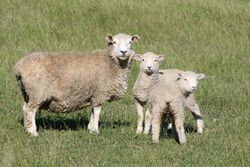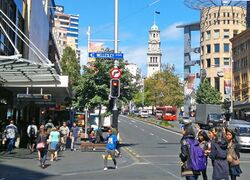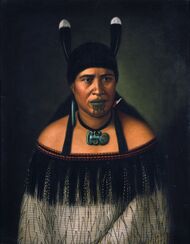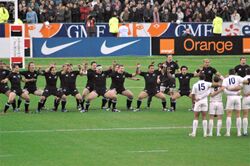New Zealand
Topic: Earth
 From HandWiki - Reading time: 71 min
From HandWiki - Reading time: 71 min
New Zealand Aotearoa (Māori) | |
|---|---|
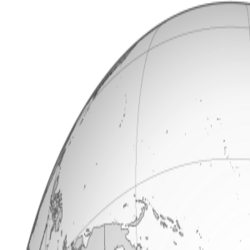 Location of New Zealand, including outlying islands, its territorial claim in the Antarctic, and Tokelau | |
| Capital | Wellington [ ⚑ ] 41°18′S 174°47′E / 41.3°S 174.783°E |
| Largest city | Auckland |
| Official languages |
|
| Ethnic groups (2018)[3] |
|
| Religion (2018)[4] |
|
| Demonym(s) |
|
| Government | Unitary parliamentary constitutional monarchy |
• Monarch | Charles III |
• Governor-General | Cindy Kiro |
• Prime Minister | Christopher Luxon |
| Legislature | Parliament (House of Representatives) |
| Stages of independence from the United Kingdom | |
• Treaty of Waitangi[5] | 6 February 1840 |
• Responsible government | 7 May 1856 |
• Dominion | 26 September 1907 |
• Statute of Westminster adopted | 25 November 1947 |
• Constitution Act 1986 | 1 January 1987 |
| Area | |
• Total | 268,021[6] km2 (103,483 sq mi) (75th) |
• Water (%) | 1.6[n 4] |
| Population | |
• July 2024 estimate | Template:Increase neutral Template:Data New Zealand[8] ({{{population estimate rank}}}) |
• 2018 census | Template:Increase neutral 4,699,755[9] |
• Density | 19.1/km2 (49.5/sq mi) (167th) |
| GDP (PPP) | 2023 estimate |
• Total | |
• Per capita | |
| GDP (nominal) | 2023 estimate |
• Total | |
• Per capita | |
| Gini (2022) | medium |
| HDI (2021) | very high · 13th |
| Currency | New Zealand dollar ($) ({{{currency code}}}) |
| Time zone | UTC+12 (NZST[n 5]) |
• Summer (DST) | UTC+13 (NZDT[n 6]) |
| Date format | dd/mm/yyyy[14] |
| Driving side | left |
| Calling code | +64 |
| ISO 3166 code | NZ |
| Internet TLD | .nz |
New Zealand (Māori: Aotearoa [aɔˈtɛaɾɔa]) is an island country in the southwestern Pacific Ocean. It consists of two main landmasses—the North Island (Te Ika-a-Māui) and the South Island (Te Waipounamu)—and over 700 smaller islands. It is the sixth-largest island country by area and lies east of Australia across the Tasman Sea and south of the islands of New Caledonia, Fiji, and Tonga. The country's varied topography and sharp mountain peaks, including the Southern Alps, owe much to tectonic uplift and volcanic eruptions. New Zealand's capital city is Wellington, and its most populous city is Auckland.
The islands of New Zealand were the last large habitable land to be settled by humans. Between about 1280 and 1350, Polynesians began to settle in the islands and then developed a distinctive Māori culture. In 1642, the Dutch explorer Abel Tasman became the first European to sight and record New Zealand. In 1840, representatives of the United Kingdom and Māori chiefs signed the Treaty of Waitangi, which in its English version declared British sovereignty over the islands. In 1841, New Zealand became a colony within the British Empire. Subsequently, a series of conflicts between the colonial government and Māori tribes resulted in the alienation and confiscation of large amounts of Māori land. New Zealand became a dominion in 1907; it gained full statutory independence in 1947, retaining the monarch as head of state. Today, the majority of New Zealand's population of 5.25 million is of European descent; the indigenous Māori are the largest minority, followed by Asians and Pacific Islanders. Reflecting this, New Zealand's culture is mainly derived from Māori and early British settlers, with recent broadening of culture arising from increased immigration. The official languages are English, Māori, and New Zealand Sign Language, with the local dialect of English being dominant.
A developed country, it was the first to introduce a minimum wage, and the first to give women the right to vote. It ranks very highly in international measures of quality of life, human rights, and it has low levels of perceived corruption. It retains visible levels of inequality, having structural disparities between its Māori and European populations. New Zealand underwent major economic changes during the 1980s, which transformed it from a protectionist to a liberalised free-trade economy. The service sector dominates the national economy, followed by the industrial sector, and agriculture; international tourism is also a significant source of revenue.
Nationally, legislative authority is vested in an elected, unicameral Parliament, while executive political power is exercised by the Government, led by the prime minister, currently Christopher Luxon. Charles III is the country's king and is represented by the governor-general. In addition, New Zealand is organised into 11 regional councils and 67 territorial authorities for local government purposes. The Realm of New Zealand also includes Tokelau (a dependent territory); the Cook Islands and Niue (self-governing states in free association with New Zealand); and the Ross Dependency, which is New Zealand's territorial claim in Antarctica.
New Zealand is a member of the United Nations , Commonwealth of Nations, ANZUS, UKUSA, OECD, ASEAN Plus Six, Asia-Pacific Economic Cooperation, the Pacific Community and the Pacific Islands Forum. It enjoys particularly close relations with the United States and is one of its major non-NATO allies;[15] the United Kingdom ; and with Australia, with a shared "Trans-Tasman" identity between the two countries.[16]
Etymology
The first European visitor to New Zealand, Dutch explorer Abel Tasman, named the islands Staten Land, believing they were part of the Staten Landt that Jacob Le Maire had sighted off the southern end of South America.[17][18] Hendrik Brouwer proved that the South American land was a small island in 1643, and Dutch cartographers subsequently renamed Tasman's discovery Nova Zeelandia from Latin, after the Dutch province of Zeeland.[17][19] This name was later anglicised to New Zealand.[20][21]
This was written as Nu Tireni in the Māori language (spelled Nu Tirani in Te Tiriti o Waitangi). In 1834 a document written in Māori and entitled "He Wakaputanga o te Rangatiratanga o Nu Tireni" was translated into English and became the Declaration of the Independence of New Zealand. It was prepared by Te W(h)akaminenga o Nga Rangatiratanga o Nga Hapu o Nu Tireni, the United Tribes of New Zealand, and a copy was sent to King William IV who had already acknowledged the flag of the United Tribes of New Zealand, and who recognised the declaration in a letter from Lord Glenelg.[22][23]
Aotearoa (pronounced [aɔˈtɛaɾɔa] in Māori and /ˌaʊtɛəˈroʊ.ə/ in English; often translated as 'land of the long white cloud')[24] is the current Māori name for New Zealand. It is unknown whether Māori had a name for the whole country before the arrival of Europeans; Aotearoa originally referred to just the North Island.[25] Māori had several traditional names for the two main islands, including Te Ika-a-Māui ("the fish of Māui") for the North Island and Te Waipounamu ("the waters of greenstone") or Te Waka o Aoraki ("the canoe of Aoraki") for the South Island.[26] Early European maps labelled the islands North (North Island), Middle (South Island), and South (Stewart Island / Rakiura).[27] In 1830, mapmakers began to use "North" and "South" on their maps to distinguish the two largest islands, and by 1907, this was the accepted norm.[21] The New Zealand Geographic Board discovered in 2009 that the names of the North Island and South Island had never been formalised, and names and alternative names were formalised in 2013. This set the names as North Island or Te Ika-a-Māui, and South Island or Te Waipounamu.[28] For each island, either its English or Māori name can be used, or both can be used together.[28] Similarly the Māori and English names for the whole country are sometimes used together (Aotearoa New Zealand);[29][30] however, this has no official recognition.[31]
In Moriori, the indigenous language of the Chatham Islands, the words Aote and Aotea are terms thought to refer to mainland New Zealand.[32][33]
History

New Zealand was the last major landmass settled by humans. The story of Kupe as the first human to set foot on the New Zealand archipelago, accredited to by most Māori iwi, is considered credible by historians; he is generally believed to have existed historically.[37] Most histories claim that this occurred approximately 40 generations ago (between 900 and 1200 AD).[38] The more specific reasons for Kupe's semi-legendary journey, and the migration of Māori in general, are contested. It is thought by some historians that Hawaiki and other Polynesian islands were experiencing considerable internal conflict at that time, which is thought to have caused an exodus from them. Some historians contend that this was because of the fallout from the 1257 Samalas eruption, which caused crop devastation globally and possibly helped trigger the Little Ice Age.[39][40]
Radiocarbon dating, evidence of deforestation[41] and mitochondrial DNA variability within Māori populations[42] suggest that Eastern Polynesians first settled the New Zealand archipelago between 1250 and 1300,[26][43] although newer archaeological and genetic research points to a date no earlier than about 1280, with at least the main settlement period between about 1320 and 1350,[44][45] consistent with evidence based on genealogical traditions.[46][47] This represented a culmination in a long series of voyages through the Pacific islands.[48] It is the broad consensus of historians that the settlement of New Zealand by Eastern Polynesians was planned and deliberate.[49] Over the centuries that followed, the Polynesian settlers developed a distinct culture now known as Māori. The population formed different iwi (tribes) and hapū (subtribes) which would sometimes cooperate, sometimes compete and sometimes fight against each other.[50] At some point, a group of Māori migrated to Rēkohu, now known as the Chatham Islands, where they developed their distinct Moriori culture.[51][52] The Moriori population was all but wiped out between 1835 and 1862 in the Moriori genocide, largely because of Taranaki Māori invasion and enslavement in the 1830s, although European diseases also contributed. In 1862, only 101 survived, and the last known full-blooded Moriori died in 1933.[53]
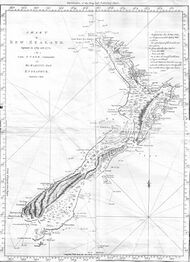
In a hostile 1642 encounter between Ngāti Tūmatakōkiri and Dutch explorer Abel Tasman's crew,[54][55] four of Tasman's crew members were killed, and at least one Māori was hit by canister shot.[56] Europeans did not revisit New Zealand until 1769, when British explorer James Cook mapped almost the entire coastline.[55] Following Cook, New Zealand was visited by numerous European and North American whaling, sealing, and trading ships. They traded European food, metal tools, weapons, and other goods for timber, Māori food, artefacts, and water.[57] The introduction of the potato and the musket transformed Māori agriculture and warfare. Potatoes provided a reliable food surplus, which enabled longer and more sustained military campaigns.[58] The resulting intertribal Musket Wars encompassed over 600 battles between 1801 and 1840, killing 30,000–40,000 Māori.[59] From the early 19th century, Christian missionaries began to settle New Zealand, eventually converting most of the Māori population.[60] The Māori population declined to around 40% of its pre-contact level during the 19th century; introduced diseases were the major factor.[61]
The British Government appointed James Busby as British Resident to New Zealand in 1832.[62] His duties, given to him by Governor Bourke in Sydney, were to protect settlers and traders "of good standing", prevent "outrages" against Māori, and apprehend escaped convicts.[62][63] In 1835, following an announcement of impending French settlement by Charles de Thierry, the nebulous United Tribes of New Zealand sent a Declaration of Independence to King William IV of the United Kingdom asking for protection.[62] Ongoing unrest, the proposed settlement of New Zealand by the New Zealand Company (which had already sent its first ship of surveyors to buy land from Māori) and the dubious legal standing of the Declaration of Independence prompted the Colonial Office to send Captain William Hobson to claim sovereignty for the United Kingdom and negotiate a treaty with the Māori.[64] The Treaty of Waitangi was first signed in the Bay of Islands on 6 February 1840.[65] In response to the New Zealand Company's attempts to establish an independent settlement in Wellington,[66][67] Hobson declared British sovereignty over all of New Zealand on 21 May 1840, even though copies of the treaty were still circulating throughout the country for Māori to sign.[68] With the signing of the treaty and declaration of sovereignty, the number of immigrants, particularly from the United Kingdom, began to increase.[69]
New Zealand was administered as a dependency of the Colony of New South Wales until becoming a separate Crown colony, the Colony of New Zealand, on 3 May 1841.[70][71] Armed conflict began between the colonial government and Māori in 1843 with the Wairau Affray over land and disagreements over sovereignty. These conflicts, mainly in the North Island, saw thousands of imperial troops and the Royal Navy come to New Zealand and became known as the New Zealand Wars. Following these armed conflicts, large areas of Māori land were confiscated by the government to meet settler demands.[72]
The colony gained a representative government in 1852, and the first Parliament met in 1854.[73] In 1856 the colony effectively became self-governing, gaining responsibility over all domestic matters (except native policy, which was granted in the mid-1860s).[73] Following concerns that the South Island might form a separate colony, premier Alfred Domett moved a resolution to transfer the capital from Auckland to a locality near Cook Strait.[74][75] Wellington was chosen for its central location, with Parliament officially sitting there for the first time in 1865.[76]
In 1886, New Zealand annexed the volcanic Kermadec Islands, about 1,000 km (620 mi) northeast of Auckland. Since 1937, the islands are uninhabited except for about six people at Raoul Island station. These islands put the northern border of New Zealand at 29 degrees South latitude.[77] After the 1982 UNCLOS, the islands contributed significantly to New Zealand's exclusive economic zone.[78]
In 1891 the Liberal Party came to power as the first organised political party.[79] The Liberal Government, led by Richard Seddon for most of its period in office,[80] passed many important social and economic measures. In 1893 New Zealand was the first nation in the world to grant all women the right to vote[79] and in 1894 pioneered the adoption of compulsory arbitration between employers and unions.[81] The Liberals also guaranteed a minimum wage in 1894, a world first.[82]
In 1907, at the request of the New Zealand Parliament, King Edward VII proclaimed New Zealand a Dominion within the British Empire,[83] reflecting its self-governing status.[84] In 1947, New Zealand adopted the Statute of Westminster, confirming that the British Parliament could no longer legislate for the country without its consent. The British government's residual legislative powers were later removed by the Constitution Act 1986, and final rights of appeal to British courts were abolished in 2003.[73]
Early in the 20th century, New Zealand was involved in world affairs, fighting in the First and Second World Wars[85] and suffering through the Great Depression.[86] The depression led to the election of the first Labour Government and the establishment of a comprehensive welfare state and a protectionist economy.[87] New Zealand experienced increasing prosperity following the Second World War,[88] and Māori began to leave their traditional rural life and move to the cities in search of work.[89] A Māori protest movement developed, which criticised Eurocentrism and worked for greater recognition of Māori culture and of the Treaty of Waitangi.[90] In 1975, a Waitangi Tribunal was set up to investigate alleged breaches of the Treaty, and it was enabled to investigate historic grievances in 1985.[65] The government has negotiated settlements of these grievances with many iwi,[91] although Māori claims to the foreshore and seabed proved controversial in the 2000s.[92][93]
Government and politics
King of New Zealand
New Zealand is a constitutional monarchy with a parliamentary democracy,[94] although its constitution is not codified.[95] Charles III is the king of New Zealand[96] and thus the head of state.[97] The king is represented by the governor-general, whom he appoints on the advice of the prime minister.[98] The governor-general can exercise the Crown's prerogative powers, such as reviewing cases of injustice and making appointments of ministers, ambassadors, and other key public officials,[99] and in rare situations, the reserve powers (e.g. the power to dissolve Parliament or refuse the royal assent of a bill into law).[100] The powers of the monarch and the governor-general are limited by constitutional constraints, and they cannot normally be exercised without the advice of ministers.[100]
The New Zealand Parliament holds legislative power and consists of the king and the House of Representatives.[101] It also included an upper house, the Legislative Council, until this was abolished in 1950.[101] The supremacy of parliament over the Crown and other government institutions was established in England by the Bill of Rights 1689 and has been ratified as law in New Zealand.[101] The House of Representatives is democratically elected, and a government is formed from the party or coalition with the majority of seats. If no majority is formed, a minority government can be formed if support from other parties during confidence and supply votes is assured.[101] The governor-general appoints ministers under advice from the prime minister, who is by convention the parliamentary leader of the governing party or coalition.[102] Cabinet, formed by ministers and led by the prime minister, is the highest policy-making body in government and responsible for deciding significant government actions.[103] Members of Cabinet make major decisions collectively and are therefore collectively responsible for the consequences of these decisions.[104] The 42nd and current prime minister, since 27 November 2023, is Christopher Luxon.[105]
A parliamentary general election must be called no later than three years after the previous election.[106] Almost all general elections between Template:NZ election link year and Template:NZ election link year were held under the first-past-the-post voting system.[107] Since the Template:NZ election link, a form of proportional representation called mixed-member proportional (MMP) has been used.[95] Under the MMP system, each person has two votes; one is for a candidate standing in the voter's electorate, and the other is for a party. Based on the 2018 census data, there are 72 electorates (which include seven Māori electorates in which only Māori can optionally vote),[108] and the remaining 48 of the 120 seats are assigned so that representation in Parliament reflects the party vote, with the threshold that a party must win at least one electorate or 5% of the total party vote before it is eligible for a seat.[109] Elections since the 1930s have been dominated by two political parties, National and Labour. More parties have been represented in Parliament since the introduction of MMP.[110]
New Zealand's judiciary, headed by the chief justice,[111] includes the Supreme Court, Court of Appeal, the High Court, and subordinate courts.[112] Judges and judicial officers are appointed non-politically and under strict rules regarding tenure to help maintain judicial independence.[95] This theoretically allows the judiciary to interpret the law based solely on the legislation enacted by Parliament without other influences on their decisions.[113]
New Zealand is identified as one of the world's most stable and well-governed states.[114] (As of 2017) the country was ranked fourth in the strength of its democratic institutions,[115] and first in government transparency and lack of corruption.[116] LGBT rights in the nation are also recognised as among the most tolerant in Oceania.[117] New Zealand ranks highly for civic participation in the political process, with 82% voter turnout during recent general elections, compared to an OECD average of 69%.[118] However, this is untrue for local council elections; a historically low 36% of eligible New Zealanders voted in the 2022 local elections, compared with an already low 42% turnout in 2019.[119][120][121] A 2017 human rights report by the United States Department of State noted that the New Zealand government generally respected the rights of individuals, but voiced concerns regarding the social status of the Māori population.[122] In terms of structural discrimination, the New Zealand Human Rights Commission has asserted that there is strong, consistent evidence that it is a real and ongoing socioeconomic issue.[123] One example of structural inequality in New Zealand can be seen in the criminal justice system. According to the Ministry of Justice, Māori are overrepresented, comprising 45% of New Zealanders convicted of crimes and 53% of those imprisoned, while only being 16.5% of the population.[124][125]
Foreign relations and military
During the period of the New Zealand colony, Britain was responsible for external trade and foreign relations.[126] The 1923 and 1926 Imperial Conferences decided that New Zealand should be allowed to negotiate its own political treaties, and the first commercial treaty was ratified in 1928 with Japan. On 3 September 1939, New Zealand allied itself with Britain and declared war on Germany with Prime Minister Michael Joseph Savage proclaiming, "Where she goes, we go; where she stands, we stand".[127]
In 1951 the United Kingdom became increasingly focused on its European interests,[128] while New Zealand joined Australia and the United States in the ANZUS security treaty.[129] The influence of the United States on New Zealand weakened following protests over the Vietnam War,[130] the refusal of the United States to admonish France after the sinking of the Rainbow Warrior,[131] disagreements over environmental and agricultural trade issues, and New Zealand's nuclear-free policy.[132][133] Despite the United States's suspension of ANZUS obligations, the treaty remained in effect between New Zealand and Australia, whose foreign policy has followed a similar historical trend.[134] Close political contact is maintained between the two countries, with free trade agreements and travel arrangements that allow citizens to visit, live and work in both countries without restrictions.[135] (As of 2013) there were about 650,000 New Zealand citizens living in Australia, which is equivalent to 15% of the population of New Zealand.[136]
New Zealand has a strong presence among the Pacific Island countries.[137] A large proportion of New Zealand's aid goes to these countries, and many Pacific people migrate to New Zealand for employment.[138] Permanent migration is regulated under the 1970 Samoan Quota Scheme and the 2002 Pacific Access Category, which allow up to 1,100 Samoan nationals and up to 750 other Pacific Islanders respectively to become permanent New Zealand residents each year. A seasonal workers scheme for temporary migration was introduced in 2007, and in 2009 about 8,000 Pacific Islanders were employed under it.[139] New Zealand is involved in the Pacific Islands Forum, the Pacific Community, Asia-Pacific Economic Cooperation, and the Association of Southeast Asian Nations Regional Forum (including the East Asia Summit).[135] New Zealand has been described as a middle power in the Asia-Pacific region,[140] and an emerging power.[141][142] The country is a member of the United Nations,[143] the Commonwealth of Nations[144] and the Organisation for Economic Co-operation and Development (OECD),[145] and participates in the Five Power Defence Arrangements.[146]
New Zealand's military services—the Defence Force—comprise the New Zealand Army, the Royal New Zealand Air Force , and the Royal New Zealand Navy.[147] New Zealand's national defence needs are modest since a direct attack is unlikely.[148] However, its military has had a global presence. The country fought in both world wars, with notable campaigns in Gallipoli, Crete,[149] El Alamein,[150] and Cassino.[151] The Gallipoli campaign played an important part in fostering New Zealand's national identity[152][153] and strengthened the ANZAC tradition it shares with Australia.[154]
In addition to Vietnam and the two world wars, New Zealand fought in the Second Boer War,[155] the Korean War,[156] the Malayan Emergency,[157] the Gulf War, and the Afghanistan War. It has contributed forces to several regional and global peacekeeping missions, such as those in Cyprus, Somalia, Bosnia and Herzegovina, the Sinai, Angola, Cambodia, the Iran–Iraq border, Bougainville, East Timor, and the Solomon Islands.[158]
Today, New Zealand enjoys particularly close relations with the United States and is one of its major non-NATO allies,[15] as well as with Australia, with a "Trans-Tasman" identity between citizens of the latter being common.[16] New Zealand is a member of the Five Eyes intelligence sharing agreement, known formally as the UKUSA Agreement. The five members of this agreement compromise the core Anglosphere: Australia, Canada, New Zealand, the United Kingdom, and the United States.[159] Since 2012, New Zealand has had a partnership arrangement with NATO under the Partnership Interoperability Initiative.[160][161][162]
Local government and external territories
The early European settlers divided New Zealand into provinces, which had a degree of autonomy.[163] Because of financial pressures and the desire to consolidate railways, education, land sales, and other policies, government was centralised and the provinces were abolished in 1876.[164] The provinces are remembered in regional public holidays[165] and sporting rivalries.[166]
Since 1876, various councils have administered local areas under legislation determined by the central government.[163][167] In 1989, the government reorganised local government into the current two-tier structure of regional councils and territorial authorities.[168] The 249 municipalities[168] that existed in 1975 have now been consolidated into 67 territorial authorities and 11 regional councils.[169] The regional councils' role is to regulate "the natural environment with particular emphasis on resource management",[168] while territorial authorities are responsible for sewage, water, local roads, building consents, and other local matters.[170][171] Five of the territorial councils are unitary authorities and also act as regional councils.[171] The territorial authorities consist of 13 city councils, 53 district councils, and the Chatham Islands Council. While officially the Chatham Islands Council is not a unitary authority, it undertakes many functions of a regional council.[172]
The Realm of New Zealand, one of 15 Commonwealth realms,[173] is the entire area over which the king or queen of New Zealand is sovereign and comprises New Zealand, Tokelau, the Ross Dependency, the Cook Islands, and Niue.[94] The Cook Islands and Niue are self-governing states in free association with New Zealand.[174][175] The New Zealand Parliament cannot pass legislation for these countries, but with their consent can act on behalf of them in foreign affairs and defence. Tokelau is classified as a non-self-governing territory, but is administered by a council of three elders (one from each Tokelauan atoll).[176] The Ross Dependency is New Zealand's territorial claim in Antarctica, where it operates the Scott Base research facility.[177] New Zealand nationality law treats all parts of the realm equally, so most people born in New Zealand, the Cook Islands, Niue, Tokelau, and the Ross Dependency are New Zealand citizens.[178][n 7]
Geography and environment
New Zealand is located near the centre of the water hemisphere and is made up of two main islands and more than 700 smaller islands.[180] The two main islands (the North Island, or Te Ika-a-Māui, and the South Island, or Te Waipounamu) are separated by Cook Strait, 22 kilometres (14 mi) wide at its narrowest point.[181] Besides the North and South Islands, the five largest inhabited islands are Stewart Island (across the Foveaux Strait), Chatham Island, Great Barrier Island (in the Hauraki Gulf),[182] D'Urville Island (in the Marlborough Sounds)[183] and Waiheke Island (about 22 km (14 mi) from central Auckland).[184]
New Zealand is long and narrow—over 1,600 kilometres (990 mi) along its north-north-east axis with a maximum width of 400 kilometres (250 mi)[185]—with about 15,000 km (9,300 mi) of coastline[186] and a total land area of 268,000 square kilometres (103,500 sq mi).[187] Because of its far-flung outlying islands and long coastline, the country has extensive marine resources. Its exclusive economic zone is one of the largest in the world, covering more than 15 times its land area.[188]
The South Island is the largest landmass of New Zealand. It is divided along its length by the Southern Alps.[189] There are 18 peaks over 3,000 metres (9,800 ft), the highest of which is Aoraki / Mount Cook at 3,724 metres (12,218 ft).[190] Fiordland's steep mountains and deep fiords record the extensive ice age glaciation of this southwestern corner of the South Island.[191] The North Island is less mountainous but is marked by volcanism.[192] The highly active Taupō Volcanic Zone has formed a large volcanic plateau, punctuated by the North Island's highest mountain, Mount Ruapehu (2,797 metres (9,177 ft)). The plateau also hosts the country's largest lake, Lake Taupō,[180] nestled in the caldera of one of the world's most active supervolcanoes.[193] New Zealand is prone to earthquakes and volcanic eruptions.
The country owes its varied topography, and perhaps even its emergence above the waves, to the dynamic boundary it straddles between the Pacific and Indo-Australian Plates.[194] New Zealand is part of Zealandia, a microcontinent nearly half the size of Australia that gradually submerged after breaking away from the Gondwanan supercontinent.[195][196] About 25 million years ago, a shift in plate tectonic movements began to contort and crumple the region. This is now most evident in the Southern Alps, formed by compression of the crust beside the Alpine Fault. Elsewhere, the plate boundary involves the subduction of one plate under the other, producing the Puysegur Trench to the south, the Hikurangi Trench east of the North Island, and the Kermadec and Tonga Trenches[197] further north.[194]
New Zealand, together with Australia, is part of a region known as Australasia.[198] It also forms the southwestern extremity of the geographic and ethnographic region called Polynesia.[199] Oceania is a wider region encompassing the Australian continent, New Zealand, and various island countries in the Pacific Ocean that are not included in the seven-continent model.[200]
- Landscapes of New Zealand
The Emerald Lakes, Mount Tongariro
Climate
New Zealand's climate is predominantly temperate maritime (Köppen: Cfb), with mean annual temperatures ranging from 10 °C (50 °F) in the south to 16 °C (61 °F) in the north.[201] Historical maxima and minima are 42.4 °C (108.32 °F) in Rangiora, Canterbury and −25.6 °C (−14.08 °F) in Ranfurly, Otago.[202] Conditions vary sharply across regions from extremely wet on the West Coast of the South Island to semi-arid in Central Otago and the Mackenzie Basin of inland Canterbury and subtropical in Northland.[203][204] Of the seven largest cities, Christchurch is the driest, receiving on average only 618 millimetres (24.3 in) of rain per year and Wellington the wettest, receiving almost twice that amount.[205] Auckland, Wellington and Christchurch all receive a yearly average of more than 2,000 hours of sunshine. The southern and southwestern parts of the South Island have a cooler and cloudier climate, with around 1,400–1,600 hours; the northern and northeastern parts of the South Island are the sunniest areas of the country and receive about 2,400–2,500 hours.[206] The general snow season is early June until early October, though cold snaps can occur outside this season.[207] Snowfall is common in the eastern and southern parts of the South Island and mountain areas across the country.[201]
| Location | January high °C (°F) |
January low °C (°F) |
July high °C (°F) |
July low °C (°F) |
Annual rainfall mm (in) |
|---|---|---|---|---|---|
| Auckland | 23 (73) | 15 (59) | 15 (59) | 8 (46) | 1,212 (47.7) |
| Wellington | 20 (68) | 14 (57) | 11 (52) | 6 (43) | 1,207 (47.5) |
| Hokitika | 20 (68) | 12 (54) | 12 (54) | 3 (37) | 2,901 (114.2) |
| Christchurch | 23 (73) | 12 (54) | 11 (52) | 2 (36) | 618 (24.3) |
| Alexandra | 25 (77) | 11 (52) | 8 (46) | −2 (28) | 359 (14.1) |
Biodiversity
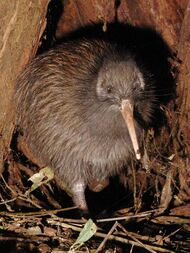
New Zealand's geographic isolation for 80 million years[209] and island biogeography has influenced evolution of the country's species of animals, fungi and plants. Physical isolation has caused biological isolation, resulting in a dynamic evolutionary ecology with examples of distinctive plants and animals as well as populations of widespread species.[210][211] The flora and fauna of New Zealand were originally thought to have originated from New Zealand's fragmentation off from Gondwana, however more recent evidence postulates species resulted from dispersal.[212] About 82% of New Zealand's indigenous vascular plants are endemic, covering 1,944 species across 65 genera.[213][214] The number of fungi recorded from New Zealand, including lichen-forming species, is not known, nor is the proportion of those fungi which are endemic, but one estimate suggests there are about 2,300 species of lichen-forming fungi in New Zealand[213] and 40% of these are endemic.[215] The two main types of forest are those dominated by broadleaf trees with emergent podocarps, or by southern beech in cooler climates.[216] The remaining vegetation types consist of grasslands, the majority of which are tussock.[217]
Before the arrival of humans, an estimated 80% of the land was covered in forest, with only high alpine, wet, infertile and volcanic areas without trees.[218] Massive deforestation occurred after humans arrived, with around half the forest cover lost to fire after Polynesian settlement.[219] Much of the remaining forest fell after European settlement, being logged or cleared to make room for pastoral farming, leaving forest occupying only 23% of the land.[220]
The forests were dominated by birds, and the lack of mammalian predators led to some like the kiwi, kākāpō, weka and takahē evolving flightlessness.[221] The arrival of humans, associated changes to habitat, and the introduction of rats, ferrets and other mammals led to the extinction of many bird species, including large birds like the moa and Haast's eagle.[222][223]
Other indigenous animals are represented by reptiles (tuatara, skinks and geckos), frogs,[224] such as the protected endangered Hamilton's Frog, spiders,[225] insects (wētā),[226] and snails.[227] Some, such as the tuatara, are so unique that they have been called living fossils.[228] Three species of bats (one since extinct) were the only sign of native land mammals in New Zealand until the 2006 discovery of bones from a unique, mouse-sized land mammal at least 16 million years old.[229][230] Marine mammals, however, are abundant, with almost half the world's cetaceans (whales, dolphins, and porpoises) and large numbers of fur seals reported in New Zealand waters.[231] Many seabirds breed in New Zealand, a third of them unique to the country.[232] More penguin species are found in New Zealand than in any other country, with 13 of the world's 18 penguin species.[233]
Since human arrival, almost half of the country's vertebrate species have become extinct, including at least fifty-one birds, three frogs, three lizards, one freshwater fish, and one bat. Others are endangered or have had their range severely reduced.[222] However, New Zealand conservationists have pioneered several methods to help threatened wildlife recover, including island sanctuaries, pest control, wildlife translocation, fostering and ecological restoration of islands and other protected areas.[234][235][236][237]
Economy
New Zealand has an advanced market economy,[238] ranked 13th in the (As of 2021) Human Development Index,[12] and fourth in the (As of 2022) Index of Economic Freedom.[239] It is a high-income economy with a nominal gross domestic product (GDP) per capita of United States dollar 36,254.[240] The currency is the New Zealand dollar, informally known as the "Kiwi dollar"; it also circulates in the Cook Islands (see Cook Islands dollar), Niue, Tokelau, and the Pitcairn Islands.[241]
Historically, extractive industries have contributed strongly to New Zealand's economy, focusing at different times on sealing, whaling, flax, gold, kauri gum, and native timber.[242] The first shipment of refrigerated meat on the Dunedin in 1882 led to the establishment of meat and dairy exports to Britain, a trade which provided the basis for strong economic growth in New Zealand.[243] High demand for agricultural products from the United Kingdom and the United States helped New Zealanders achieve higher living standards than both Australia and Western Europe in the 1950s and 1960s.[244] In 1973, New Zealand's export market was reduced when the United Kingdom joined the European Economic Community[245] and other compounding factors, such as the 1973 oil and 1979 energy crises, led to a severe economic depression.[246] Living standards in New Zealand fell behind those of Australia and Western Europe, and by 1982 New Zealand had the lowest per-capita income of all the developed nations surveyed by the World Bank.[247] In the mid-1980s New Zealand deregulated its agricultural sector by phasing out subsidies over a three-year period.[248][249] Since 1984, successive governments engaged in major macroeconomic restructuring (known first as Rogernomics and then Ruthanasia), rapidly transforming New Zealand from a protectionist and highly regulated economy to a liberalised free-trade economy.[250][251]
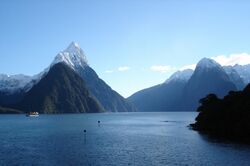
Unemployment peaked just above 10% in 1991 and 1992,[253] following the 1987 share market crash, but eventually fell to a record low (since 1986) of 3.7% in 2007 (ranking third from twenty-seven comparable OECD nations).[253] However, the global financial crisis that followed had a major effect on New Zealand, with the GDP shrinking for five consecutive quarters, the longest recession in over thirty years,[254][255] and unemployment rising back to 7% in late 2009.[256] Unemployment rates for different age groups follow similar trends but are consistently higher among youth. In the December 2014 quarter, the general unemployment rate was around 5.8%, while the unemployment rate for youth aged 15 to 21 was 15.6%.[253] New Zealand has experienced a series of "brain drains" since the 1970s[257] that still continue today.[258] Nearly one-quarter of highly skilled workers live overseas, mostly in Australia and Britain, which is the largest proportion from any developed nation.[259] In recent decades, however, a "brain gain" has brought in educated professionals from Europe and less developed countries.[260][261] Today New Zealand's economy benefits from a high level of innovation.[262]
Poverty in New Zealand is characterised by growing income inequality; wealth in New Zealand is highly concentrated,[263] with the top 1% of the population owning 16% of the country's wealth, and the richest 5% owning 38%, leaving a stark contrast where half the population, including state beneficiaries and pensioners, receive less than $24,000.[264] Moreover, child poverty in New Zealand has been identified by the Government as a major societal issue;[265][266] the country has 12.0% of children living in low-income households that had less than 50 percent of the median equivalised disposable household income (As of June 2022).[267] Poverty has a disproportionately high effect in ethnic-minority households, with a quarter (23.3%) of Māori children and almost a third (28.6%) of Pacific Islander children living in poverty (As of 2020).[265]
Trade
New Zealand is heavily dependent on international trade,[268] particularly in agricultural products.[269] Exports account for 24% of its output,[186] making New Zealand vulnerable to international commodity prices and global economic slowdowns. Food products made up 55% of the value of all the country's exports in 2014; wood was the second largest earner (7%).[270] New Zealand's main trading partners, (As of June 2018), are China (NZ$27.8b), Australia ($26.2b), the European Union ($22.9b), the United States ($17.6b), and Japan ($8.4b).[271] On 7 April 2008, New Zealand and China signed the New Zealand–China Free Trade Agreement, the first such agreement China has signed with a developed country.[272] In July 2023, New Zealand and the European Union entered into the EU–New Zealand Free Trade Agreement which eliminated tariffs on several goods traded between the two regions.[273] This free trade agreement expanded on the pre-existing free trade agreement[274] and saw a reduction in tariffs on meat and dairy[275] in response to feedback from the affected industries.[276]
The service sector is the largest sector in the economy, followed by manufacturing and construction and then farming and raw material extraction.[186] Tourism plays a significant role in the economy, contributing $12.9 billion (or 5.6%) to New Zealand's total GDP and supporting 7.5% of the total workforce in 2016.[277] In 2017, international visitor arrivals were expected to increase at a rate of 5.4% annually up to 2022.[277]
Wool was New Zealand's major agricultural export during the late 19th century.[242] Even as late as the 1960s it made up over a third of all export revenues,[242] but since then its price has steadily dropped relative to other commodities,[278] and wool is no longer profitable for many farmers.[279] In contrast, dairy farming increased, with the number of dairy cows doubling between 1990 and 2007,[280] to become New Zealand's largest export earner.[281] In the year to June 2018, dairy products accounted for 17.7% ($14.1 billion) of total exports,[271] and the country's largest company, Fonterra, controls almost one-third of the international dairy trade.[282] Other exports in 2017–18 were meat (8.8%), wood and wood products (6.2%), fruit (3.6%), machinery (2.2%) and wine (2.1%).[271] New Zealand's wine industry has followed a similar trend to dairy, the number of vineyards doubling over the same period,[283] overtaking wool exports for the first time in 2007.[284][285]
Infrastructure
In 2015, renewable energy generated 40.1% of New Zealand's gross energy supply.[286] The majority of the country's electricity supply is generated from hydroelectric power, with major schemes on the Waikato, Waitaki and Clutha / Mata-Au rivers, as well as at Manapouri. Geothermal power is also a significant generator of electricity, with several large stations located across the Taupō Volcanic Zone in the North Island. The four main companies in the generation and retail market are Contact Energy, Genesis Energy, Mercury Energy and Meridian Energy. State-owned Transpower operates the high-voltage transmission grids in the North and South Islands, as well as the Inter-Island HVDC link connecting the two together.[286]
The provision of water supply and sanitation is generally of good quality. Regional authorities provide water abstraction, treatment and distribution infrastructure to most developed areas.[287][288]
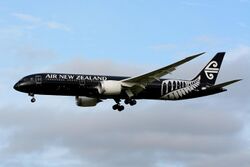
New Zealand's transport network comprises 94,000 kilometres (58,410 mi) of roads, including 199 kilometres (124 mi) of motorways,[289] and 4,128 kilometres (2,565 mi) of railway lines.[186] Most major cities and towns are linked by bus services, although the private car is the predominant mode of transport.[290] The railways were privatised in 1993 but were re-nationalised by the government in stages between 2004 and 2008. The state-owned enterprise KiwiRail now operates the railways, with the exception of commuter services in Auckland and Wellington, which are operated by Auckland One Rail and Transdev Wellington respectively.[291] Railways run the length of the country, although most lines now carry freight rather than passengers.[292] The road and rail networks in the two main islands are linked by roll-on/roll-off ferries between Wellington and Picton, operated by Interislander (part of KiwiRail) and Bluebridge. Most international visitors arrive via air.[293] New Zealand has four international airports: Auckland, Christchurch, Queenstown and Wellington; however, only Auckland and Christchurch offer non-stop flights to countries other than Australia or Fiji.[294]
The New Zealand Post Office had a monopoly over telecommunications in New Zealand until 1987 when Telecom New Zealand was formed, initially as a state-owned enterprise and then privatised in 1990.[295] Chorus, which was split from Telecom (now Spark) in 2011,[296] still owns the majority of the telecommunications infrastructure, but competition from other providers has increased.[295] A large-scale rollout of gigabit-capable fibre to the premises, branded as Ultra-Fast Broadband, began in 2009 with a target of being available to 87% of the population by 2022.[297] (As of 2017), the United Nations International Telecommunication Union ranks New Zealand 13th in the development of information and communications infrastructure.[298]
Science and technology
Early indigenous contribution to science in New Zealand was by Māori tohunga accumulating knowledge of agricultural practice and the effects of herbal remedies in the treatment of illness and disease.[299] Cook's voyages in the 1700s and Darwin's in 1835 had important scientific botanical and zoological objectives.[300] The establishment of universities in the 19th century fostered scientific discoveries by notable New Zealanders including Ernest Rutherford for splitting the atom, William Pickering for rocket science, Maurice Wilkins for helping discover DNA, Beatrice Tinsley for galaxy formation, Archibald McIndoe for plastic surgery, and Alan MacDiarmid for conducting polymers.[301]
Crown Research Institutes (CRIs) were formed in 1992 from existing government-owned research organisations. Their role is to research and develop new science, knowledge, products and services across the economic, environmental, social and cultural spectrum for the benefit of New Zealand.[302] The total gross expenditure on research and development (R&D) as a proportion of GDP rose to 1.37% in 2018, up from 1.23% in 2015. New Zealand ranks 21st in the OECD for its gross R&D spending as a percentage of GDP.[303] New Zealand was ranked 27th in the Global Innovation Index in 2023.[304]
The New Zealand Space Agency was created by the government in 2016 for space policy, regulation and sector development. Rocket Lab was the notable first commercial rocket launcher in the country.[305]
Demography
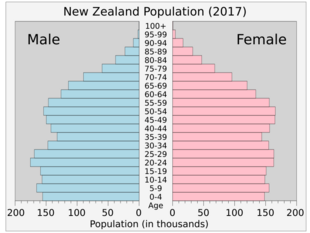
The 2018 New Zealand census enumerated a resident population of 4,699,755, an increase of 10.8% over the 2013 census figure.[3] As of July 2024, the total population has risen to an estimated Template:Data New Zealand.[8] New Zealand's population increased at a rate of 1.9% per year in the seven years ended June 2020. In September 2020 Statistics New Zealand reported that the population had climbed above 5 million people in September 2019, according to population estimates based on the 2018 census.[306][n 8]
New Zealand's population today is concentrated to the north of the country, with around 76.6% of the population living in the North Island and 23.3% in the South Island as of June 2021.[308] During the 20th century, New Zealand's population drifted north. In 1921, the country's median centre of population was located in the Tasman Sea west of Levin in Manawatū-Whanganui; by 2017, it had moved 280 km (170 mi) north to near Kawhia in Waikato.[309]
New Zealand is a predominantly urban country, with 83.9% of the population living in urban areas, and 51.0% of the population living in the seven cities with populations exceeding 100,000.[308] Auckland, with over 1.4 million residents, is by far the largest city.[308] New Zealand cities generally rank highly on international livability measures. For instance, in 2016, Auckland was ranked the world's third most liveable city and Wellington the twelfth by the Mercer Quality of Living Survey.[310]
The median age of the New Zealand population at the 2018 census was 37.4 years,[311] with life expectancy in 2017–2019 being 80.0 years for males and 83.5 years for females.[312] While New Zealand is experiencing sub-replacement fertility, with a total fertility rate of 1.6 in 2020, the fertility rate is above the OECD average.[313][314] By 2050, the median age is projected to rise to 43 years and the percentage of people 60 years of age and older to rise from 18% to 29%.[315] In 2016 the leading cause of death was cancer at 30.3%, followed by ischaemic heart disease (14.9%) and cerebrovascular disease (7.4%).[316] (As of 2016), total expenditure on health care (including private sector spending) is 9.2% of GDP.[317]
Ethnicity and immigration
In the 2018 census, 71.8% of New Zealand residents identified ethnically as European, and 16.5% as Māori. Other major ethnic groups include Asian (15.3%) and Pacific peoples (9.0%), two-thirds of whom live in the Auckland Region.[n 3][3] The population has become more multicultural and diverse in recent decades: in 1961, the census reported that the population of New Zealand was 92% European and 7% Māori, with Asian and Pacific minorities sharing the remaining 1%.[318]
While the demonym for a New Zealand citizen is New Zealander, the informal "Kiwi" is commonly used both internationally[319] and by locals.[320] The Māori loanword Pākehā has been used to refer to New Zealanders of European descent, although some reject this name. The word today is increasingly used to refer to all non-Polynesian New Zealanders.[321]
The Māori were the first people to reach New Zealand, followed by the early European settlers. Following colonisation, immigrants were predominantly from Britain, Ireland and Australia because of restrictive policies similar to the White Australia policy.[322] There was also significant Dutch, Dalmatian,[323] Germany , and Italian immigration, together with indirect European immigration through Australia, North America, South America and South Africa.[324][325] Net migration increased after the Second World War; in the 1970s and 1980s policies on immigration were relaxed, and immigration from Asia was promoted.[325][326] In 2009–10, an annual target of 45,000–50,000 permanent residence approvals was set by the New Zealand Immigration Service—more than one new migrant for every 100 New Zealand residents.[327] In the 2018 census, 27.4% of people counted were not born in New Zealand, up from 25.2% in the 2013 census. Over half (52.4%) of New Zealand's overseas-born population lives in the Auckland Region.[328] The United Kingdom remains the largest source of New Zealand's immigrant population, with around a quarter of all overseas-born New Zealanders born there; other major sources of New Zealand's overseas-born population are China , India , Australia , South Africa , Fiji and Samoa.[329] The number of fee-paying international students increased sharply in the late 1990s, with more than 20,000 studying in public tertiary institutions in 2002.[330]
Language

English is the predominant language in New Zealand, spoken by 95.4% of the population.[3] New Zealand English is a variety of the language with a distinctive accent and lexicon.[332] It is similar to Australian English, and many speakers from the Northern Hemisphere are unable to tell the accents apart.[333] The most prominent differences between the New Zealand English dialect and other English dialects are the shifts in the short front vowels: the short-i sound (as in kit) has centralised towards the schwa sound (the a in comma and about); the short-e sound (as in dress) has moved towards the short-i sound; and the short-a sound (as in trap) has moved to the short-e sound.[334]
After the Second World War, Māori were discouraged or forced from speaking their own language (te reo Māori) in schools and workplaces, and it existed as a community language only in a few remote areas.[335] The Native Schools Act 1867 required instruction in English in all schools, and while there was no official policy banning children from speaking Māori, many suffered from physical abuse if they did so.[336][337][338] The Māori language has recently undergone a process of revitalisation,[339] being declared one of New Zealand's official languages in 1987,[340] and is spoken by 4.0% of the population.[3][n 9] There are now Māori language-immersion schools and two television channels that broadcast predominantly in Māori.[342] Many places have both their Māori and English names officially recognised.[343]
As recorded in the 2018 census,[3] Samoan is the most widely spoken non-official language (2.2%), followed by "Northern Chinese" (including Mandarin, 2.0%), Hindi (1.5%), and French (1.2%). New Zealand Sign Language was reported to be understood by 22,986 people (0.5%); it became one of New Zealand's official languages in 2006.[344]
Religion
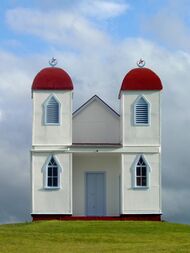
Christianity is the predominant religion in New Zealand, although its society is among the most secular in the world.[346][347] In the 2018 census, 44.7% of respondents identified with one or more religions, including 37.0% identifying as Christians. Another 48.5% indicated that they had no religion.[n 10][3] Of those who affiliate with a particular Christian denomination, the main responses are Anglicanism (6.7%),[n 11] Roman Catholicism (6.3%), and Presbyterianism (4.7%).[3] The Māori-based Ringatū and Rātana religions (1.2%) are also Christian in origin.[3][345] Immigration and demographic change in recent decades have contributed to the growth of minority religions, such as Hinduism (2.6%), Islam (1.3%), Buddhism (1.1%), and Sikhism (0.9%).[3] The Auckland Region exhibited the greatest religious diversity.[348]
Education
Primary and secondary schooling is compulsory for children aged 6 to 16, with the majority of children attending from the age of 5.[349] There are 13 school years and attending state (public) schools is free to New Zealand citizens and permanent residents from a person's 5th birthday to the end of the calendar year following their 19th birthday.[350] New Zealand has an adult literacy rate of 99%,[186] and over half of the population aged 15 to 29 hold a tertiary qualification.[349] There are five types of government-owned tertiary institutions: universities, colleges of education, polytechnics, specialist colleges, and wānanga,[351] in addition to private training establishments.[352] In 2021, in the population aged 25–64; 13% had no formal qualification, 21% had a school qualification, 28% had a tertiary certificate or diploma, and 35% have a bachelor's degree or higher.[353] The OECD's Programme for International Student Assessment ranks New Zealand as the 28th best in the OECD for maths, 13th best for science, and 11th best for reading.[354]
Culture
Early Māori adapted the tropically based east Polynesian culture in line with the challenges associated with a larger and more diverse environment, eventually developing their own distinctive culture. Social organisation was largely communal with families (whānau), subtribes (hapū) and tribes (iwi) ruled by a chief (rangatira), whose position was subject to the community's approval.[355] The British and Irish immigrants brought aspects of their own culture to New Zealand and also influenced Māori culture,[356][357] particularly with the introduction of Christianity.[358] However, Māori still regard their allegiance to tribal groups as a vital part of their identity, and Māori kinship roles resemble those of other Polynesian peoples.[359] More recently, American, Australian, Asian and other European cultures have exerted influence on New Zealand. Non-Māori Polynesian cultures are also apparent, with Pasifika, the world's largest Polynesian festival, now an annual event in Auckland.[360]
The largely rural life in early New Zealand led to the image of New Zealanders being rugged, industrious problem solvers.[361] Modesty was expected and enforced through the "tall poppy syndrome", where high achievers received harsh criticism.[362] At the time, New Zealand was not known as an intellectual country.[363] From the early 20th century until the late 1960s, Māori culture was suppressed by the attempted assimilation of Māori into British New Zealanders.[335] In the 1960s, as tertiary education became more available, and cities expanded[364] urban culture began to dominate.[365] However, rural imagery and themes are common in New Zealand's art, literature and media.[366]
New Zealand's national symbols are influenced by natural, historical, and Māori sources. The silver fern is an emblem appearing on army insignia and sporting team uniforms.[367] Certain items of popular culture thought to be unique to New Zealand are called "Kiwiana".[367]
Art
As part of the resurgence of Māori culture, the traditional crafts of carving and weaving are now more widely practised, and Māori artists are increasing in number and influence.[368] Most Māori carvings feature human figures, generally with three fingers and either a natural-looking, detailed head or a grotesque head.[369] Surface patterns consisting of spirals, ridges, notches and fish scales decorate most carvings.[370] The pre-eminent Māori architecture consisted of carved meeting houses (wharenui) decorated with symbolic carvings and illustrations. These buildings were originally designed to be constantly rebuilt, changing and adapting to different whims or needs.[371]
Māori decorated the white wood of buildings, canoes and cenotaphs using red (a mixture of red ochre and shark fat) and black (made from soot) paint and painted pictures of birds, reptiles and other designs on cave walls.[372] Māori tattoos (moko) consisting of coloured soot mixed with gum were cut into the flesh with a bone chisel.[373] Since European arrival paintings and photographs have been dominated by landscapes, originally not as works of art but as factual portrayals of New Zealand.[374] Portraits of Māori were also common, with early painters often portraying them as an ideal race untainted by civilisation.[374] The country's isolation delayed the influence of European artistic trends allowing local artists to develop their own distinctive style of regionalism.[375] During the 1960s and 1970s, many artists combined traditional Māori and Western techniques, creating unique art forms.[376] New Zealand art and craft has gradually achieved an international audience, with exhibitions in the Venice Biennale in 2001 and the "Paradise Now" exhibition in New York in 2004.[368][377]
Māori cloaks are made of fine flax fibre and patterned with black, red and white triangles, diamonds and other geometric shapes.[378] Greenstone was fashioned into earrings and necklaces, with the most well-known design being the hei-tiki, a distorted human figure sitting cross-legged with its head tilted to the side.[379] Europeans brought English fashion etiquette to New Zealand, and until the 1950s most people dressed up for social occasions.[380] Standards have since relaxed and New Zealand fashion has received a reputation for being casual, practical and lacklustre.[381][382] However, the local fashion industry has grown significantly since 2000, doubling exports and increasing from a handful to about 50 established labels, with some labels gaining international recognition.[382]
Literature
Māori quickly adopted writing as a means of sharing ideas, and many of their oral stories and poems were converted to the written form.[383] Most early English literature was obtained from Britain, and it was not until the 1950s when local publishing outlets increased that New Zealand literature started to become widely known.[384] Although still largely influenced by global trends (modernism) and events (the Great Depression), writers in the 1930s began to develop stories increasingly focused on their experiences in New Zealand. During this period, literature changed from a journalistic activity to a more academic pursuit.[385] Participation in the world wars gave some New Zealand writers a new perspective on New Zealand culture and with the post-war expansion of universities local literature flourished.[386] Dunedin is a UNESCO City of Literature.[387]
Media and entertainment
New Zealand music has been influenced by blues, jazz, country, rock and roll and hip hop, with many of these genres given a unique New Zealand interpretation.[388] Māori developed traditional chants and songs from their ancient Southeast Asian origins, and after centuries of isolation created a unique "monotonous" and "doleful" sound.[389] Flutes and trumpets were used as musical instruments[390] or as signalling devices during war or special occasions.[391] Early settlers brought over their ethnic music, with brass bands and choral music being popular, and musicians began touring New Zealand in the 1860s.[392][393] Pipe bands became widespread during the early 20th century.[394] The New Zealand recording industry began to develop from 1940 onwards, and many New Zealand musicians have obtained success in Britain and the United States.[388] Some artists release Māori language songs, and the Māori tradition-based art of kapa haka (song and dance) has made a resurgence.[395] The New Zealand Music Awards are held annually by Recorded Music NZ; the awards were first held in 1965 by Reckitt & Colman as the Loxene Golden Disc awards.[396] Recorded Music NZ also publishes the country's official weekly record charts.[397]

Public radio was introduced in New Zealand in 1922.[399] A state-owned television service began in 1960.[400] Deregulation in the 1980s saw a sudden increase in the numbers of radio and television stations.[401] New Zealand television primarily broadcasts American and British programming, along with many Australian and local shows.[402] The number of New Zealand films significantly increased during the 1970s. In 1978 the New Zealand Film Commission started assisting local film-makers, and many films attained a world audience, some receiving international acknowledgement.[401] The highest-grossing New Zealand films are Hunt for the Wilderpeople, Boy, The World's Fastest Indian, Whale Rider, Once Were Warriors, Heavenly Creatures and The Piano.[403] The country's diverse scenery and compact size, plus government incentives,[404] have encouraged some producers to shoot very big-budget and well known productions in New Zealand, including The Lord of the Rings and The Hobbit film trilogies, Avatar, The Chronicles of Narnia, King Kong, Wolverine, The Last Samurai and The Power of the Dog.[405] The New Zealand media industry is dominated by a small number of companies, most of which are foreign-owned, although the state retains ownership of some television and radio stations.[406] Since 1994, Freedom House has consistently ranked New Zealand's press freedom in the top twenty, with the 19th freest media (As of 2015)[407]
Sport
Most of the major sporting codes played in New Zealand have British origins.[408] Rugby union is considered the national sport[409] and attracts the most spectators.[410] Golf, netball, tennis and cricket have the highest rates of adult participation, while netball, rugby union and football (soccer) are particularly popular among young people.[410][411] Horse racing is one of the most popular spectator sports in New Zealand and was part of the "rugby, racing, and beer" subculture during the 1960s.[412] Around 54% of New Zealand adolescents participate in sports for their school.[411] Victorious rugby tours to Australia and the United Kingdom in the late 1880s and the early 1900s played an early role in instilling a national identity.[413] Māori participation in European sports was particularly evident in rugby, and the country's team performs a haka, a traditional Māori challenge, before international matches.[414] New Zealand is known for its extreme sports, adventure tourism[415] and strong mountaineering tradition, as seen in the success of notable New Zealander Sir Edmund Hillary.[416][417] Other outdoor pursuits such as cycling, fishing, swimming, running, tramping, canoeing, hunting, snowsports, surfing and sailing are also popular.[418] New Zealand has seen regular sailing success in the America's Cup regatta since 1995.[419] The Polynesian sport of waka ama racing has experienced a resurgence of interest in New Zealand since the 1980s.[420]
New Zealand has competitive international teams in rugby union, rugby league, netball, cricket, softball, and sailing. New Zealand participated at the Summer Olympics in 1908 and 1912 as a joint team with Australia, before first participating on its own in 1920.[421] The country has ranked highly on a medals-to-population ratio at recent Games.[422][423] The All Blacks, the national rugby union team, are the most successful in the history of international rugby[424] and have won the World Cup three times.[425]
Cuisine
The national cuisine has been described as Pacific Rim, incorporating the native Māori cuisine and diverse culinary traditions introduced by settlers and immigrants from Europe, Polynesia, and Asia.[426] New Zealand yields produce from land and sea—most crops and livestock, such as maize, potatoes and pigs, were gradually introduced by the early European settlers.[427] Distinctive ingredients or dishes include lamb, salmon, kōura (crayfish),[428] Bluff oysters, whitebait, pāua (abalone), mussels, scallops, pipi and tuatua (types of New Zealand shellfish),[429] kūmara (sweet potato), kiwifruit, tamarillo, and pavlova (considered a national dessert).[430][426] A hāngī is a traditional Māori method of cooking food using heated rocks buried in a pit oven; still used for large groups on special occasions,[431] such as tangihanga.[432]
See also
- List of New Zealand-related topics
- Outline of New Zealand
Footnotes
- ↑ "God Save the King" is officially a national anthem but is generally used only on regal and viceregal occasions.[1]
- ↑ English is a de facto official language due to its widespread use.[2]
- ↑ 3.0 3.1 Ethnicity figures add to more than 100% as people could choose more than one ethnic group.
- ↑ The proportion of New Zealand's area (excluding estuaries) covered by rivers, lakes and ponds, based on figures from the New Zealand Land Cover Database,[7] is (357526 + 81936) / (26821559 – 92499–26033 – 19216)=1.6%. If estuarine open water, mangroves, and herbaceous saline vegetation are included, the figure is 2.2%.
- ↑ The Chatham Islands have a separate time zone, 45 minutes ahead of the rest of New Zealand.
- ↑ Clocks are advanced by an hour from the last Sunday in September until the first Sunday in April.[13] Daylight saving time is also observed in the Chatham Islands, 45 minutes ahead of NZDT.
- ↑ A person born on or after 1 January 2006 acquires New Zealand citizenship at birth only if at least one parent is a New Zealand citizen or permanent resident. All persons born on or before 31 December 2005 acquired citizenship at birth (jus soli).[179]
- ↑ A provisional estimate initially indicated the milestone was reached six months later in March 2020, before population estimates were rebased from the 2013 census to the 2018 census.[307]
- ↑ In 2015, 55% of Māori adults (aged 15 years and over) reported knowledge of te reo Māori. Of these speakers, 64% use Māori at home and 50,000 can speak the language "very well" or "well".[341]
- ↑ Religion percentages may not add to 100% as people could claim multiple religions or object to answering the question.
- ↑ This is a percentage of total respondents to the census, not a percentage of Christians.
Citations
- ↑ "Protocol for using New Zealand's National Anthems". Ministry for Culture and Heritage. http://www.mch.govt.nz/nz-identity-heritage/national-anthems/protocols.
- ↑ International Covenant on Civil and Political Rights Fifth Periodic Report of the Government of New Zealand (Report). New Zealand Government. 21 December 2007. p. 89. http://mfat.govt.nz/downloads/humanrights/5th-ICCPR-report.pdf. Retrieved 18 November 2015. "In addition to the Māori language, New Zealand Sign Language is also an official language of New Zealand. The New Zealand Sign Language Act 2006 permits the use of NZSL in legal proceedings, facilitates competency standards for its interpretation and guides government departments in its promotion and use. English, the medium for teaching and learning in most schools, is a de facto official language by virtue of its widespread use. For these reasons, these three languages have special mention in the New Zealand Curriculum."
- ↑ 3.0 3.1 3.2 3.3 3.4 3.5 3.6 3.7 3.8 3.9 "Quick stats about ethnicity for New Zealand (2018 Census)". Statistics New Zealand. Source: Stats NZ and licensed by Stats NZ for reuse under the Creative Commons Attribution 4.0 International licence.. https://www.stats.govt.nz/tools/2018-census-place-summaries/new-zealand#ethnicity.
- ↑ "Quick stats about religion for New Zealand (2018 Census)". Statistics New Zealand. Source: Stats NZ and licensed by Stats NZ for reuse under the Creative Commons Attribution 4.0 International licence.. https://www.stats.govt.nz/tools/2018-census-place-summaries/new-zealand#religion.
- ↑ "Treaty of Waitangi". Manatū Taonga Ministry for Culture and Heritage. https://mch.govt.nz/treatyofwaitangi.
- ↑ "New Zealand country profile". 20 November 2023. https://www.bbc.com/news/world-asia-pacific-15357770.
- ↑ "The New Zealand Land Cover Database". New Zealand Land Cover Database 2. Ministry for the Environment. 1 July 2009. http://www.mfe.govt.nz/issues/land/land-cover-dbase/index.html.
- ↑ 8.0 8.1 "Population clock". Statistics New Zealand. https://www.stats.govt.nz/tools/population-clock. The population estimate shown is automatically calculated daily at 00:00 UTC and is based on data obtained from the population clock on the date shown in the citation.
- ↑ "2018 Census population and dwelling counts". Statistics New Zealand. 23 September 2019. https://www.stats.govt.nz/information-releases/2018-census-population-and-dwelling-counts.
- ↑ 10.0 10.1 10.2 10.3 "World Economic Outlook Database, October 2023 Edition. (NZ)". International Monetary Fund. 10 October 2023. https://www.imf.org/en/Publications/WEO/weo-database/2023/October/weo-report?c=196,&s=NGDPD,PPPGDP,NGDPDPC,PPPPC,&sy=2020&ey=2028&ssm=0&scsm=1&scc=0&ssd=1&ssc=0&sic=0&sort=country&ds=.&br=1.
- ↑ (in en) Household income and housing-cost statistics: Year ended June 2022. Statistics New Zealand. 23 March 2023. https://www.stats.govt.nz/information-releases/household-income-and-housing-cost-statistics-year-ended-june-2022/. Retrieved 22 September 2023.
- ↑ 12.0 12.1 (in en) Human Development Report 2021/2022. United Nations Development Programme. 8 September 2022. ISBN 978-9211264517. https://hdr.undp.org/system/files/documents/global-report-document/hdr2021-22pdf_1.pdf. Retrieved 8 September 2022.
- ↑ "New Zealand Daylight Time Order 2007 (SR 2007/185)". New Zealand Parliamentary Counsel Office. 6 July 2007. http://www.legislation.govt.nz/regulation/public/2007/0185/latest/whole.html.
- ↑ There is no official all-numeric date format for New Zealand, but government recommendations generally follow Australian date and time notation. See The Govt.nz style guide, New Zealand Government, 22 July 2020, https://www.digital.govt.nz/standards-and-guidance/design-and-ux/content-design-guidance/numbers/, retrieved 9 July 2021.
- ↑ 15.0 15.1 "22 USC § 2321k - Designation of major non-NATO allies". law.cornell.edu. Legal Information Institute. https://www.law.cornell.edu/uscode/text/22/2321k.
- ↑ 16.0 16.1 Lynch, Brian (2009). "THE TRANS-TASMAN WORLD: towards a closer understanding". New Zealand International Review 34 (2): 25–27.
- ↑ 17.0 17.1 Wilson, John (March 2009). "European discovery of New Zealand – Tasman's achievement". The Encyclopedia of New Zealand. http://www.teara.govt.nz/en/european-discovery-of-new-zealand/3. Retrieved 24 January 2011.
- ↑ Bathgate, John. "The Pamphlet Collection of Sir Robert Stout: Volume 44. Chapter 1, Discovery and Settlement". NZETC. http://nzetc.victoria.ac.nz//tm/scholarly/tei-Stout44-t2-body-d1-d1.html. "He named the country Staaten Land, in honour of the States-General of Holland, in the belief that it was part of the great southern continent."
- ↑ Mackay, Duncan (1986). "The Search for the Southern Land". in Fraser, B.. The New Zealand Book of Events. Auckland: Reed Methuen. pp. 52–54.
- ↑ Wood, James (1900). The Nuttall Encyclopaedia: Being a Concise and Comprehensive Dictionary of General Knowledge. London and New York: Frederick Warne & Co. p. iii. https://archive.org/stream/b24850366#page/n6/mode/1up. Retrieved 10 October 2016.
- ↑ 21.0 21.1 McKinnon, Malcolm (November 2009). "Place names – Naming the country and the main islands". The Encyclopedia of New Zealand. http://www.TeAra.govt.nz/en/place-names/1. Retrieved 24 January 2011.
- ↑ Grant (Lord Glenelg), Charles (1836). "Extract of a Despatch from Lord Glenelg to Major-General Sir Richard Bourke, New South Wales". http://www.waitangi.co.nz/declarationindependence.htm#Extract.
- ↑ Palmer 2008, p. 41.
- ↑ King 2003, p. 41.
- ↑ Hay, Maclagan & Gordon 2008, p. 72.
- ↑ 26.0 26.1 Mein Smith 2005, p. 6.
- ↑ Brunner, Thomas (1851). The Great Journey: An expedition to explore the interior of the Middle Island, New Zealand, 1846-8. Royal Geographical Society. http://www.nzetc.org/tm/scholarly/BruJour-fig-BruJour_P001a.html.
- ↑ 28.0 28.1 Williamson, Maurice (10 October 2013). "Names of NZ's two main islands formalised" (Press release). New Zealand Government. Retrieved 1 May 2017.
- ↑ Ministry of Health (24 June 2021). "COVID-19: Elimination strategy for Aotearoa New Zealand". https://www.health.govt.nz/our-work/diseases-and-conditions/covid-19-novel-coronavirus/covid-19-response-planning/covid-19-elimination-strategy-aotearoa-new-zealand.
- ↑ Larner, Wendy (31 May 2021). "COVID-19 in Aotearoa New Zealand". Journal of the Royal Society of New Zealand 51 (sup1): S1–S3. doi:10.1080/03036758.2021.1908208. Bibcode: 2021JRSNZ..51S...1L.
- ↑ "Using 'Aotearoa' and 'New Zealand' together 'as it should be' - Jacinda Ardern" (in en). Newshub. 17 December 2019. https://www.newshub.co.nz/home/politics/2019/12/using-aotearoa-and-new-zealand-together-as-it-should-be-jacinda-ardern.html.
- ↑ New Zealand Government. "Moriori and the Trustees of the Moriori Imi Settlement Trust and the Crown Deed of Settlement of Historical Claims". https://www.govt.nz/assets/Documents/OTS/Moriori/moriori-deed-of-settlement-initialled.pdf.
- ↑ Te Papa (25 August 2020). "Repatriation and return of karāpuna to Rēkohu". https://www.tepapa.govt.nz/repatriation-and-return-karapuna-rekohu.
- ↑ Anderson, Atholl; Spriggs, Matthew (1993). "Late colonization of East Polynesia". Antiquity 67 (255): 200–217. doi:10.1017/S0003598X00045324. ISSN 1745-1744.
- ↑ Jacomb, Chris; Anderson, Atholl; Higham, Thomas (1999). "Dating the first New Zealanders: The chronology of Wairau Bar". Antiquity 73 (280): 420–427. doi:10.1017/S0003598X00088360. ISSN 1745-1744.
- ↑ Wilmshurst, J. M.; Hunt, T. L.; Lipo, C. P.; Anderson, A. J. (2010). "High-precision radiocarbon dating shows recent and rapid initial human colonization of East Polynesia". Proceedings of the National Academy of Sciences of the United States of America 108 (5): 1815–20. doi:10.1073/pnas.1015876108. PMID 21187404. Bibcode: 2011PNAS..108.1815W.
- ↑ "Kupe". https://collections.tepapa.govt.nz/topic/10732.
- ↑ "Kupe". https://archive.hokulea.com/ike/moolelo/kupe.html.
- ↑ "2: Tangata Whenua" (in en-nz). 8 October 2019. https://www.rnz.co.nz/programmes/the-aotearoa-history-show/story/2018716783/2-tangata-whenua.
- ↑ McConnell, Joseph R.; Chellman, Nathan J.; Mulvaney, Robert; Eckhardt, Sabine; Stohl, Andreas; Plunkett, Gill; Kipfstuhl, Sepp; Freitag, Johannes et al. (6 October 2021). "Hemispheric black carbon increase after the 13th-century Māori arrival in New Zealand". Nature 598 (7879): 82–85. doi:10.1038/s41586-021-03858-9. PMID 34616056. Bibcode: 2021Natur.598...82M. https://par.nsf.gov/servlets/purl/10347866. Retrieved 24 May 2023.
- ↑ McGlone, M.; Wilmshurst, J. M. (1999). "Dating initial Maori environmental impact in New Zealand". Quaternary International 59 (1): 5–16. doi:10.1016/S1040-6182(98)00067-6. Bibcode: 1999QuInt..59....5M.
- ↑ Murray-McIntosh, Rosalind P.; Scrimshaw, Brian J.; Hatfield, Peter J.; Penny, David (1998). "Testing migration patterns and estimating founding population size in Polynesia by using human mtDNA sequences". Proceedings of the National Academy of Sciences of the United States of America 95 (15): 9047–52. doi:10.1073/pnas.95.15.9047. PMID 9671802. Bibcode: 1998PNAS...95.9047M.
- ↑ Wilmshurst, J. M.; Anderson, A. J.; Higham, T. F. G.; Worthy, T. H. (2008). "Dating the late prehistoric dispersal of Polynesians to New Zealand using the commensal Pacific rat". Proceedings of the National Academy of Sciences of the United States of America 105 (22): 7676–80. doi:10.1073/pnas.0801507105. PMID 18523023. Bibcode: 2008PNAS..105.7676W.
- ↑ Jacomb, Chris; Holdaway, Richard N.; Allentoft, Morten E.; Bunce, Michael; Oskam, Charlotte L.; Walter, Richard; Brooks, Emma (2014). "High-precision dating and ancient DNA profiling of moa (Aves: Dinornithiformes) eggshell documents a complex feature at Wairau Bar and refines the chronology of New Zealand settlement by Polynesians". Journal of Archaeological Science 50: 24–30. doi:10.1016/j.jas.2014.05.023. Bibcode: 2014JArSc..50...24J. http://researchrepository.murdoch.edu.au/id/eprint/23310/.
- ↑ Walters, Richard; Buckley, Hallie; Jacomb, Chris; Matisoo-Smith, Elizabeth (7 October 2017). "Mass Migration and the Polynesian Settlement of New Zealand". Journal of World Prehistory 30 (4): 351–376. doi:10.1007/s10963-017-9110-y.
- ↑ Roberton, J. B. W. (1956). "Genealogies as a basis for Maori chronology". Journal of the Polynesian Society 65 (1): 45–54. http://www.jps.auckland.ac.nz/document/Volume_65_1956/Volume_65,_No._1/Genealogies_as_a_basis_for_Maori_chronology,_by_J._B._W._Roberton,_p_45%9654/p1. Retrieved 22 March 2020.
- ↑ Te Hurinui, Pei (1958). "Maori genealogies". Journal of the Polynesian Society 67 (2): 162–165. http://jps.auckland.ac.nz/document/Volume_67_1958/Volume_67%2C_No._2/Maori_genealogies%2C_by_Pei_Te_Hurinui%2C_p_162-165/p1. Retrieved 22 March 2020.
- ↑ Moodley, Y.; Linz, B.; Yamaoka, Y. et al. (2009). "The Peopling of the Pacific from a Bacterial Perspective". Science 323 (5913): 527–530. doi:10.1126/science.1166083. PMID 19164753. Bibcode: 2009Sci...323..527M.
- ↑ Walter, Richard; Buckley, Hallie; Jacomb, Chris; Matisoo-Smith, Elizabeth (1 December 2017). "Mass Migration and the Polynesian Settlement of New Zealand" (in en). Journal of World Prehistory 30 (4): 351–376. doi:10.1007/s10963-017-9110-y. ISSN 1573-7802.
- ↑ Ballara, Angela (1998). Iwi: The Dynamics of Māori Tribal Organisation from c. 1769 to c. 1945 (1st ed.). Wellington: Victoria University Press. ISBN 9780864733283.
- ↑ Clark, Ross (1994). "Moriori and Māori: The Linguistic Evidence". in Sutton, Douglas. The Origins of the First New Zealanders. Auckland: Auckland University Press. pp. 123–135.
- ↑ Davis, Denise (September 2007). "The impact of new arrivals". The Encyclopedia of New Zealand. http://www.teara.govt.nz/en/moriori/4. Retrieved 30 April 2010.
- ↑ Davis, Denise; Solomon, Māui (March 2009). "Moriori – The impact of new arrivals". The Encyclopedia of New Zealand. http://www.TeAra.govt.nz/en/moriori/4. Retrieved 23 March 2011.
- ↑ Mitchell, Hillary (10 February 2015). "Te Tau Ihu". Ministry for Culture and Heritage. http://www.teara.govt.nz/en/te-tau-ihu-tribes.
- ↑ 55.0 55.1 Mein Smith 2005, p. 23.
- ↑ Salmond, Anne (1991). Two Worlds: First Meetings Between Maori and Europeans 1642–1772. Auckland: Penguin Books. p. 82. ISBN 0-670-83298-7.
- ↑ King 2003, p. 122.
- ↑ Fitzpatrick, John (2004). "Food, warfare and the impact of Atlantic capitalism in Aotearo/New Zealand". Australasian Political Studies Association Conference: APSA 2004 Conference Papers. https://www.adelaide.edu.au/apsa/docs_papers/Others/Fitzpatrick.pdf.
- ↑ Brailsford, Barry (1972). Arrows of Plague. Wellington: Hick Smith and Sons. p. 35. ISBN 0-456-01060-2.
- ↑ Wagstrom, Thor (2005). "Broken Tongues and Foreign Hearts". in Brock, Peggy. Indigenous Peoples and Religious Change. Boston: Brill Academic Publishers. pp. 71 and 73. ISBN 978-90-04-13899-5.
- ↑ Lange, Raeburn (1999). May the people live: a history of Māori health development 1900–1920. Auckland University Press. p. 18. ISBN 978-1-86940-214-3.
- ↑ 62.0 62.1 62.2 Orange, Claudia (1990). "Busby, James – Biography". in Oliver, W. H.; Orange, Claudia; Phillips, Jock. Dictionary of New Zealand Biography, Te Ara: The Encyclopedia of New Zealand. https://teara.govt.nz/en/biographies/1b54/busby-james. Retrieved 7 January 2011.
- ↑ "First British Resident comes ashore" (in en). New Zealand Ministry for Culture and Heritage. 24 December 2020. https://nzhistory.govt.nz/james-busby-inaugurated-british-resident.
- ↑ Foster, Bernard John (April 2009). "Sir George Gipps". in McLintock, Alexander Hare. An Encyclopaedia of New Zealand. http://www.teara.govt.nz/en/1966/gipps-sir-george/1. Retrieved 20 March 2021.
- ↑ 65.0 65.1 Wilson, John (16 September 2016). "Nation and government – The origins of nationhood". in Phillips, Jock. The Encyclopedia of New Zealand. https://teara.govt.nz/en/nation-and-government/page-1. Retrieved 20 March 2021.
- ↑ McLintock, Alexander Hare, ed (April 2009). "Settlement from 1840 to 1852". An Encyclopaedia of New Zealand. http://www.teara.govt.nz/en/1966/land-settlement/3. Retrieved 7 January 2011.
- ↑ Foster, Bernard John (April 2009). "Akaroa, French Settlement At". in McLintock, Alexander Hare. An Encyclopaedia of New Zealand. http://www.teara.govt.nz/en/1966/akaroa-french-settlement-at/1. Retrieved 7 January 2011.
- ↑ Simpson, K. A. (1990). "Hobson, William – Biography". in Oliver, W. H.; Orange, Claudia; Phillips, Jock. Dictionary of New Zealand Biography, Te Ara: The Encyclopedia of New Zealand. https://teara.govt.nz/en/biographies/1h29/hobson-william. Retrieved 20 March 2021.
- ↑ Phillips, Jock (1 August 2015). "History of immigration – British immigration and the New Zealand Company". in Phillips, Jock. The Encyclopedia of New Zealand. https://teara.govt.nz/en/history-of-immigration/page-3. Retrieved 20 March 2021.
- ↑ "Crown colony era – the Governor-General". New Zealand Ministry for Culture and Heritage. March 2009. http://www.nzhistory.net.nz/politics/history-of-the-governor-general/crown-colony-era.
- ↑ Moon, Paul (2010). New Zealand Birth Certificates – 50 of New Zealand's Founding Documents. AUT Media. p. 66. ISBN 978-0-95829971-8.
- ↑ "New Zealand's 19th-century wars – overview". New Zealand Ministry for Culture and Heritage. April 2009. http://www.nzhistory.net.nz/war/new-zealands-19th-century-wars/introduction.
- ↑ 73.0 73.1 73.2 Wilson, John (16 September 2016). "Government and nation – From colony to nation". in Phillips, Jock. The Encyclopedia of New Zealand. http://www.TeAra.govt.nz/en/nation-and-government/page-2. Retrieved 2 February 2011.
- ↑ Temple, Philip (1980). Wellington Yesterday. John McIndoe. ISBN 0-86868-012-5.
- ↑ Levine, Stephen (13 July 2012). "Capital city – A new capital". The Encyclopedia of New Zealand. http://www.teara.govt.nz/en/capital-city/page-3. Retrieved 4 May 2015.
- ↑ "Parliament moves to Wellington". New Zealand Ministry for Culture and Heritage. January 2017. https://nzhistory.govt.nz/parliament-sits-for-the-first-time-in-wellington.
- ↑ Jobberns, George (1966). "Kermadec Islands". in McLintock, A. H.. An Encyclopaedia of New Zealand, Te Ara. https://teara.govt.nz/en/1966/kermadec-islands. Retrieved 18 March 2022.
- ↑ "Pacific Island Exclusive Economic Zones". https://teara.govt.nz/en/map/6964/pacific-island-exclusive-economic-zones.
- ↑ 79.0 79.1 Wilson, John (March 2009). "History – Liberal to Labour". The Encyclopedia of New Zealand. http://www.TeAra.govt.nz/en/history/page-5. Retrieved 27 April 2017.
- ↑ Hamer, David. "Seddon, Richard John". Dictionary of New Zealand Biography. Ministry for Culture and Heritage. https://teara.govt.nz/en/biographies/2s11.
- ↑ Boxall, Peter; Haynes, Peter (1997). "Strategy and Trade Union Effectiveness in a Neo-liberal Environment" (PDF). British Journal of Industrial Relations 35 (4): 567–591. doi:10.1111/1467-8543.00069. http://www.gurn.info/en/topics/global-trade-union-strategies-union-renewal/organizational-innovation-and-change/industrial-relations-and-labour-regulations-affecting-unions2019-structure/strategy-and-trade-union-effectiveness-in-a-neo-liberal-environment.
- ↑ "A brief history of the minimum wage in New Zealand" (in en). Newshub. https://www.newshub.co.nz/home/money/2018/12/a-brief-history-of-the-minimum-wage-in-new-zealand.html.
- ↑ Proclamation. 10 September 1907. p. 6149. https://www.thegazette.co.uk/London/issue/28058/page/6149
- ↑ "Dominion status – Becoming a dominion". New Zealand Ministry for Culture and Heritage. September 2014. https://nzhistory.govt.nz/culture/dominion-day/becoming-dominion.
- ↑ "War and Society". New Zealand Ministry for Culture and Heritage. http://www.nzhistory.net.nz/war-and-society.
- ↑ Easton, Brian (April 2010). "Economic history – Interwar years and the great depression". The Encyclopedia of New Zealand. http://www.TeAra.govt.nz/en/economic-history/7. Retrieved 7 January 2011.
- ↑ Derby, Mark (May 2010). "Strikes and labour disputes – Wars, depression and first Labour government". The Encyclopedia of New Zealand. http://www.TeAra.govt.nz/en/strikes-and-labour-disputes/6. Retrieved 1 February 2011.
- ↑ Easton, Brian (November 2010). "Economic history – Great boom, 1935–1966". The Encyclopedia of New Zealand. http://www.TeAra.govt.nz/en/economic-history/9. Retrieved 1 February 2011.
- ↑ Keane, Basil (November 2010). "Te Māori i te ohanga – Māori in the economy – Urbanisation". The Encyclopedia of New Zealand. http://www.TeAra.govt.nz/en/te-maori-i-te-ohanga-maori-in-the-economy/6. Retrieved 7 January 2011.
- ↑ Royal, Te Ahukaramū (March 2009). "Māori – Urbanisation and renaissance". The Encyclopedia of New Zealand. http://www.teara.govt.nz/en/maori/5. Retrieved 1 February 2011.
- ↑ Healing the Past, Building a Future: A Guide to Treaty of Waitangi Claims and Negotiations with the Crown. Office of Treaty Settlements. March 2015. ISBN 978-0-478-32436-5. https://www.govt.nz/assets/Documents/Red-Book-Healing-the-past-building-a-future.pdf. Retrieved 26 April 2017.
- ↑ Report on the Crown's Foreshore and Seabed Policy (Report). Ministry of Justice. https://forms.justice.govt.nz/search/WT/reports/reportSummary.html?reportId=wt_DOC_68000605. Retrieved 26 April 2017.
- ↑ Barker, Fiona (June 2012). "Debate about the foreshore and seabed". The Encyclopedia of New Zealand. http://www.teara.govt.nz/en/video/34605/debate-about-the-foreshore-and-seabed. Retrieved 26 April 2017.
- ↑ 94.0 94.1 "New Zealand's Constitution". Office of the Governor-General of New Zealand. http://www.gg.govt.nz/role/constofnz.htm.
- ↑ 95.0 95.1 95.2 "Factsheet – New Zealand – Political Forces". The Economist. 15 February 2005. http://economist.com/countries/NewZealand/profile.cfm?folder=Profile-Political%20Forces.
- ↑ "Royal Titles Act 1974". New Zealand Parliamentary Counsel Office. February 1974. Section 1. http://www.legislation.govt.nz/act/public/1974/0001/latest/DLM411814.html.
- ↑ Constitution Act 1986. New Zealand Parliamentary Counsel Office. 1 January 1987. Section 2.1. http://www.legislation.govt.nz/act/public/1986/0114/latest/whole.html#DLM94210. Retrieved 15 July 2018. "The Sovereign in right of New Zealand is the head of State of New Zealand, and shall be known by the royal style and titles proclaimed from time to time."
- ↑ "The Role of the Governor-General". Office of the Governor-General of New Zealand. 27 February 2017. https://gg.govt.nz/role.
- ↑ Harris, Bruce (2009). "Replacement of the Royal Prerogative in New Zealand". New Zealand Universities Law Review 23: 285–314. https://www.britannica.com/bps/additionalcontent/18/41876855/REPLACEMENT-OF-THE-ROYAL-PREROGATIVE-IN-NEW-ZEALAND. Retrieved 28 August 2016.
- ↑ 100.0 100.1 "The Reserve Powers". Office of the Governor-General of New Zealand. http://www.gg.govt.nz/role/powers.htm.
- ↑ 101.0 101.1 101.2 101.3 "Parliament Brief: What is Parliament?". New Zealand Parliament. https://www.parliament.nz/en/visit-and-learn/how-parliament-works/fact-sheets/pbrief7/.
- ↑ McLean, Gavin (February 2015). "Premiers and prime ministers". The Encyclopedia of New Zealand. http://www.teara.govt.nz/en/premiers-and-prime-ministers. Retrieved 30 November 2016.
- ↑ Wilson, John (November 2010). "Government and nation – System of government". The Encyclopedia of New Zealand. http://www.TeAra.govt.nz/en/government-and-nation/4. Retrieved 9 January 2011.
- ↑ "Principles of Cabinet decision making". Cabinet Manual. Department of the Prime Minister and Cabinet. 2008. http://www.cabinetmanual.cabinetoffice.govt.nz/5.11.
- ↑ "Christopher Luxon sworn in as New Zealand's new prime minister". 1News. TVNZ. 27 November 2023. https://www.1news.co.nz/2023/11/27/christopher-luxon-sworn-in-as-new-zealands-new-prime-minister/.
- ↑ "The electoral cycle". Cabinet Manual. Department of the Prime Minister and Cabinet. 2008. https://cabinetmanual.cabinetoffice.govt.nz/6.2.
- ↑ "First past the post – the road to MMP". New Zealand Ministry for Culture and Heritage. September 2009. http://www.nzhistory.net.nz/politics/fpp-to-mmp/first-past-the-post.
- ↑ "Number of electorates and electoral populations: 2018 Census". Stats.Govt.nz. Statistics New Zealand. 23 September 2019. https://www.stats.govt.nz/information-releases/number-of-electorates-and-electoral-populations-2018-census.
- ↑ "Sainte-Laguë allocation formula". Electoral Commission. 4 February 2013. http://www.elections.org.nz/voting-system/mmp-voting-system/sainte-lagu%C3%AB-allocation-formula.
- ↑ Curtin, Jennifer; Miller, Raymond (21 July 2015). "Political parties". Te Ara: The Encyclopedia of New Zealand. https://teara.govt.nz/en/political-parties. Retrieved 24 July 2023.
- ↑ "Role of the Chief Justice". Courts of New Zealand. https://www.courtsofnz.govt.nz/about-the-judiciary/role-judges/role-chief.
- ↑ "Structure of the court system". Courts of New Zealand. https://www.courtsofnz.govt.nz/about-the-judiciary/structure-of-the-court-system.
- ↑ "The Judiciary". Ministry of Justice. http://www.justice.govt.nz/courts/the-judiciary.
- ↑ "Fragile States Index Heat Map". Fragile States Index. https://fragilestatesindex.org/analytics/fsi-heat-map/.
- ↑ "Democracy Index 2017". Economist Intelligence Unit. 2018. p. 5. http://pages.eiu.com/rs/753-RIQ-438/images/Democracy_Index_2017.pdf.
- ↑ "Corruption Perceptions Index 2017". Transparency International. 21 February 2018. https://www.transparency.org/news/feature/corruption_perceptions_index_2017.
- ↑ Carroll, Aengus (May 2016). "State Sponsored Homophobia 2016: A world survey of sexual orientation laws: criminalisation, protection and recognition". International Lesbian, Gay, Bisexual, Trans and Intersex Association. p. 183. http://ilga.org/downloads/02_ILGA_State_Sponsored_Homophobia_2016_ENG_WEB_150516.pdf. "In Australia and New Zealand, lesbian, gay, and bisexual people continue to enjoy many legal rights denied to their comrades across the vast majority of the Pacific."
- ↑ "New Zealand". OECD Better Life Index. Organisation for Economic Co-operation and Development. http://www.oecdbetterlifeindex.org/countries/new-zealand/.
- ↑ "Council election turnout: Low participation revives call for online voting" (in en-nz). 10 October 2022. https://www.rnz.co.nz/news/local-elections-2022%20/476379/council-election-turnout-low-participation-revives-call-for-online-voting.
- ↑ "Auckland councillor says record low local election turnout 'extremely concerning'" (in en-NZ). 30 May 2023. https://www.nzherald.co.nz/nz/local-elections-2022-calls-for-review-over-extremely-concerning-record-low-turnout/TMDMIHJEO7ER7C6LYD3DRWES24/.
- ↑ "The media and low local election turnout" (in en-nz). 13 October 2022. https://www.rnz.co.nz/national/programmes/mediawatch/audio/2018862513/the-media-and-low-local-election-turnout.
- ↑ "New Zealand". Country Reports on Human Rights Practices for 2017. United States Department of State. https://2009-2017.state.gov/j/drl/rls/hrrpt/humanrightsreport/index.htm?year=2017&dlid=277105.
- ↑ "A fair go for all? Rite tahi tätou katoa? Addressing Structural Discrimination in Public Services". Human Rights Commission. 2012. p. 50. http://www.hrc.co.nz/wp-content/uploads/2012/08/HRC-Structural-Report_final_webV1.pdf/.
- ↑ Cornish, Sophie (1 May 2022). "Māori even more overrepresented in prisons, despite $98m strategy" (in en). https://www.stuff.co.nz/national/128306867/mori-even-more-overrepresented-in-prisons-despite-98m-strategy.
- ↑ "Hāpaitia te Oranga Tangata | New Zealand Ministry of Justice". https://www.justice.govt.nz/justice-sector-policy/key-initiatives/key-initiatives-archive/hapaitia-te-oranga-tangata/#:~:text=M%C4%81ori%20are%20overrepresented%20at%20every,of%20the%20New%20Zealand%20population..
- ↑ McLintock, Alexander, ed (April 2009). "External Relations". An Encyclopaedia of New Zealand. http://www.teara.govt.nz/en/1966/history-constitutional/10. Retrieved 7 January 2011.
- ↑ "Michael Joseph Savage". New Zealand Ministry for Culture and Heritage. July 2010. http://www.nzhistory.net.nz/people/michael-joseph-savage-biography.
- ↑ Patman, Robert (2005). "Globalisation, Sovereignty, and the Transformation of New Zealand Foreign Policy". Working Paper 21/05. Centre for Strategic Studies, Victoria University of Wellington. p. 8. http://www.victoria.ac.nz/css/docs/Working_Papers/WP21.pdf.
- ↑ "Department of External Affairs: Security Treaty between Australia, New Zealand and the United States of America". Australian Government. September 1951. http://www.australianpolitics.com/foreign/anzus/anzus-treaty.shtml.
- ↑ "The Vietnam War". New Zealand History. New Zealand Ministry for Culture and Heritage. June 2008. http://www.nzhistory.net.nz/war/vietnam-war.
- ↑ "Sinking the Rainbow Warrior – nuclear-free New Zealand". New Zealand History. New Zealand Ministry for Culture and Heritage. August 2008. http://www.nzhistory.net.nz/politics/nuclear-free-new-zealand/rainbow-warrior.
- ↑ "Nuclear-free legislation – nuclear-free New Zealand". New Zealand History. New Zealand Ministry for Culture and Heritage. August 2008. http://www.nzhistory.net.nz/politics/nuclear-free-new-zealand/nuclear-free-zone.
- ↑ Lange, David (1990). Nuclear Free: The New Zealand Way. Penguin Books. ISBN 0-14-014519-2.
- ↑ "Australia in brief". Australian Department of Foreign Affairs and Trade. http://www.dfat.gov.au/aib/history.html.
- ↑ 135.0 135.1 "New Zealand country brief". Australian Department of Foreign Affairs and Trade. http://www.dfat.gov.au/geo/new_zealand/nz_country_brief.html.
- ↑ Collett, John (4 September 2013). "Kiwis face hurdles in pursuit of lost funds". http://www.smh.com.au/money/super-and-funds/kiwis-face-hurdles-in-pursuit-of-lost-funds-20130903-2t1jl.html#ixzz2glaaulCe.
- ↑ Mark, Simon (11 January 2021). "New Zealand's public diplomacy in the Pacific: a reset, or more of the same?" (in en). Place Branding and Public Diplomacy 18 (2): 105–112. doi:10.1057/s41254-020-00196-x. ISSN 1751-8059. PMC 7798375. https://doi.org/10.1057/s41254-020-00196-x.
- ↑ Bertram, Geoff (April 2010). "South Pacific economic relations – Aid, remittances and tourism". The Encyclopedia of New Zealand. http://www.TeAra.govt.nz/en/south-pacific-economic-relations/4. Retrieved 11 January 2011.
- ↑ Howes, Stephen (November 2010). "Making migration work: Lessons from New Zealand". Development Policy Centre. http://devpolicy.org/making-migration-work-lessons-from-new-zealand/.
- ↑ Institute, Lowy. "New Zealand – Lowy Institute Asia Power Index" (in en). https://power.lowyinstitute.org/countries/new-zealand/.
- ↑ "Caught between China and the US: The Kiwi place in a newly confrontational world". Stuff.co.nz. 7 June 2019. https://www.stuff.co.nz/national/politics/113097493/caught-between-china-and-the-us-the-kiwi-place-in-a-newly-confrontational-world.
- ↑ Steff, Reuben (5 June 2018). "New Zealand's Pacific reset: strategic anxieties about rising China". University of Waikato. https://www.waikato.ac.nz/news-opinion/media/2018/new-zealands-pacific-reset-strategic-anxieties-about-rising-china.
- ↑ "Member States of the United Nations". United Nations. https://www.un.org/en/members/index.shtml#n.
- ↑ "New Zealand". The Commonwealth. 15 August 2013. http://thecommonwealth.org/our-member-countries/new-zealand.
- ↑ "Members and partners". Organisation for Economic Co-operation and Development. http://www.oecd.org/pages/0,3417,en_36734052_36761800_1_1_1_1_1,00.html.
- ↑ "The Future of the Five Power Defence Arrangements". The Strategist. Australian Strategic Policy Institute. 8 November 2012. https://www.aspistrategist.org.au/the-future-of-the-five-power-defence-arrangements/.
- ↑ "About Us: Role and Responsibilities". New Zealand Defence Force. http://www.nzdf.mil.nz/about-us/.
- ↑ Ayson, Robert (2007). "New Zealand Defence and Security Policy, 1990–2005". in Alley, Roderic. New Zealand in World Affairs. IV: 1990–2005. Wellington: Victoria University Press. p. 132. ISBN 978-0-86473-548-5.
- ↑ "The Battle for Crete". New Zealand History. New Zealand Ministry for Culture and Heritage. May 2010. http://www.nzhistory.net.nz/war/the-battle-for-crete.
- ↑ "El Alamein – The North African Campaign". New Zealand History. New Zealand Ministry for Culture and Heritage. May 2009. http://www.nzhistory.net.nz/war/the-north-african-campaign/el-alamein.
- ↑ Holmes, Richard (September 2010). "World War Two: The Battle of Monte Cassino". https://www.bbc.co.uk/history/worldwars/wwtwo/battle_cassino_01.shtml.
- ↑ "Gallipoli stirred new sense of national identity says Clark". The New Zealand Herald. April 2005. http://www.nzherald.co.nz/nz/news/article.cfm?c_id=1&objectid=10122323.
- ↑ Prideaux, Bruce (2007). Ryan, Chris. ed. Battlefield Tourism: History, Place and Interpretation. Elsevier Science. p. 18. ISBN 978-0-08-045362-0.
- ↑ Burke, Arthur. "The Spirit of ANZAC". ANZAC Day Commemoration Committee. http://www.anzacday.org.au/spirit/spirit2.html.
- ↑ "South African War 1899–1902". New Zealand Ministry for Culture and Heritage. February 2009. http://www.nzhistory.net.nz/war/the-south-african-boer-war/introduction.
- ↑ "New Zealand in the Korean War". New Zealand History. New Zealand Ministry for Culture and Heritage. https://nzhistory.govt.nz/war/korean-war.
- ↑ "NZ and the Malayan Emergency". New Zealand Ministry for Culture and Heritage. August 2010. http://www.nzhistory.net.nz/war/the-malayan-emergency.
- ↑ "New Zealand Defence Force Overseas Operations". New Zealand Defence Force. January 2008. http://www.nzdf.mil.nz/operations/default.htm.
- ↑ "Five Eyes Intelligence Oversight and Review Council (FIORC)". https://www.dni.gov/index.php/who-we-are/organizations/enterprise-capacity/chco/chco-related-menus/chco-related-links/recruitment-and-outreach/217-about/organization/icig-pages/2660-icig-fiorc.
- ↑ "Relations with New Zealand". https://www.nato.int/cps/en/natohq/topics_52347.htm.
- ↑ "Partnership arrangement signed with NATO". NZ Govt. https://www.beehive.govt.nz/release/partnership-arrangement-signed-nato.
- ↑ Scotcher, Katie (3 April 2023). "New Zealand's relationship to Nato is getting stronger, expert says". New Zealand Herald. https://www.nzherald.co.nz/nz/new-zealands-relationship-to-nato-is-getting-stronger-expert-says/46LJXVTY4REX3OE6DGLADS54DA/.
- ↑ 163.0 163.1 "New Zealand's Nine Provinces (1853–76)". Friends of the Hocken Collections. University of Otago. March 2000. http://www.library.otago.ac.nz/pdf/hoc_fr_bulletins/31_bulletin.pdf.
- ↑ McLintock, Alexander, ed (April 2009). "Provincial Divergencies". An Encyclopaedia of New Zealand. http://www.TeAra.govt.nz/en/1966/provinces-and-provincial-districts/3. Retrieved 7 January 2011.
- ↑ Swarbrick, Nancy (September 2016). "Public holidays". The Encyclopedia of New Zealand. http://TeAra.govt.nz/en/public-holidays. Retrieved 25 June 2017.
- ↑ "Overview – regional rugby". New Zealand Ministry for Culture and Heritage. September 2010. http://www.nzhistory.net.nz/culture/regional-rugby/overview.
- ↑ Dollery, Brian; Keogh, Ciaran; Crase, Lin (2007). "Alternatives to Amalgamation in Australian Local Government: Lessons from the New Zealand Experience". Sustaining Regions 6 (1): 50–69. http://www.anzrsai.org/system/files/f8/f9/f39/f40/o186//Dollery%20sustaining%20regions%20article.pdf.
- ↑ 168.0 168.1 168.2 Sancton, Andrew (2000). Merger mania: the assault on local government. McGill-Queen's University Press. p. 84. ISBN 0-7735-2163-1.
- ↑ "Subnational population estimates at 30 June 2010 (boundaries at 1 November 2010)". Statistics New Zealand. 26 October 2010. http://www.stats.govt.nz/~/media/Statistics/Methods%20and%20Services/Tables/Subnational%20population%20estimates/subpopest2001-10.ashx.
- ↑ Smelt & Jui Lin 2009, p. 33.
- ↑ 171.0 171.1 "Glossary". Department of Internal Affairs. http://www.localcouncils.govt.nz/lgip.nsf/wpgurl/Resources-Glossary-Index.
- ↑ "Chatham Islands Council Act 1995 No 41". New Zealand Parliamentary Counsel Office. 29 July 1995. http://www.legislation.govt.nz/act/public/1995/0041/latest/whole.html.
- ↑ Gimpel, Diane (2011). Monarchies. ABDO Publishing Company. p. 22. ISBN 978-1-617-14792-0. https://archive.org/details/monarchies0000gimp_v0v5. Retrieved 18 November 2016.
- ↑ "System of Government". Government of Niue. http://www.gov.nu/wb/pages/system-of-government-fakatokaaga-he-fakatufono.php.
- ↑ "Government – Structure, Personnel". Government of the Cook Islands. http://www.ck/govt.htm#con.
- ↑ "Tokelau Government". Government of Tokelau. http://www.tokelau.org.nz/Tokelau+Government.html.
- ↑ "Scott Base". Antarctica New Zealand. http://www.antarcticanz.govt.nz/scott-base.
- ↑ "Citizenship Act 1977 No 61". Zealand Parliamentary Counsel Office. 1 December 1977. http://www.legislation.govt.nz/act/public/1977/0061/latest/whole.html.
- ↑ "Check if you're a New Zealand citizen". Department of Internal Affairs. http://www.dia.govt.nz/diawebsite.nsf/wpg_URL/Services-Citizenship-Check-if-you're-a-New-Zealand-citizen?OpenDocument.
- ↑ 180.0 180.1 Walrond, Carl (8 February 2005). "Natural environment – Geography and geology". The Encyclopedia of New Zealand. https://teara.govt.nz/en/natural-environment/page-1.
- ↑ McLintock, Alexander, ed (April 2009). "The Sea Floor". An Encyclopaedia of New Zealand. http://www.TeAra.govt.nz/en/1966/cook-strait/1. Retrieved 13 January 2011.
- ↑ "Hauraki Gulf islands". Auckland City Council. http://www.aucklandcity.govt.nz/auckland/introduction/hauraki/default.asp.
- ↑ Hindmarsh (2006). "Discovering D'Urville". Heritage New Zealand. http://www.historic.org.nz/en/Publications/HeritageNZMagazine/HeritageNz2006/HNZ06-DiscoveringDUrville.aspx.
- ↑ "Distance tables". Auckland Coastguard. http://www.auckland-coastguard.org.nz/Information/Distance+Tables.html.
- ↑ McKenzie, D. W. (1987). Heinemann New Zealand atlas. Heinemann Publishers. ISBN 0-7900-0187-X.
- ↑ 186.0 186.1 186.2 186.3 186.4 "New Zealand". The World Factbook. US Central Intelligence Agency. 25 February 2021. https://www.cia.gov/the-world-factbook/countries/new-zealand/.
- ↑ "Geography". Statistics New Zealand. 1999. http://www2.stats.govt.nz/domino/external/PASFull/pasfull.nsf/84bf91b1a7b5d7204c256809000460a4/4c2567ef00247c6acc25697a00043f15?OpenDocument.
- ↑ Offshore Options: Managing Environmental Effects in New Zealand's Exclusive Economic Zone. Wellington: Ministry for the Environment. 2005. ISBN 0-478-25916-6. http://www.mfe.govt.nz/sites/default/files/offshore-options-jun05.pdf. Retrieved 23 June 2017.
- ↑ Coates, Glen (2002). The rise and fall of the Southern Alps. Canterbury University Press. p. 15. ISBN 0-908812-93-0.
- ↑ Garden 2005, p. 52.
- ↑ Grant, David (March 2009). "Southland places – Fiordland's coast". The Encyclopedia of New Zealand. http://www.TeAra.govt.nz/en/southland-places/10. Retrieved 14 January 2011.
- ↑ "Central North Island volcanoes". New Zealand Department of Conservation. http://www.doc.govt.nz/parks-and-recreation/national-parks/tongariro/features/central-north-island-volcanoes/.
- ↑ "Taupō". GNS Science. http://www.geonet.org.nz/volcano/activity/taupo/about.html.
- ↑ 194.0 194.1 Lewis, Keith; Nodder, Scott; Carter, Lionel (March 2009). "Sea floor geology – Active plate boundaries". The Encyclopedia of New Zealand. http://www.TeAra.govt.nz/en/sea-floor-geology/2. Retrieved 4 February 2011.
- ↑ Wallis, G. P.; Trewick, S. A. (2009). "New Zealand phylogeography: Evolution on a small continent". Molecular Ecology 18 (17): 3548–3580. doi:10.1111/j.1365-294X.2009.04294.x. PMID 19674312. Bibcode: 2009MolEc..18.3548W.
- ↑ Mortimer, Nick; Campbell, Hamish (2014). Zealandia: Our Continent Revealed. Auckland: Penguin Books. ISBN 978-0-14-357156-8. OCLC 887230882.
- ↑ Wright, Dawn; Bloomer, Sherman; MacLeod, Christopher; Taylor, Brian; Goodliffe, Andrew (2000). "Bathymetry of the Tonga Trench and Forearc: A Map Series". Marine Geophysical Researches 21 (5): 489–512. doi:10.1023/A:1026514914220. Bibcode: 2000MarGR..21..489W.
- ↑ Deverson, Tony; Kennedy, Graeme, eds (2005). "Australasia". New Zealand Oxford Dictionary. Oxford University Press. doi:10.1093/acref/9780195584516.001.0001. ISBN 9780195584516.
- ↑ Hobbs, Joseph J. (2016). Fundamentals of World Regional Geography. Cengage Learning. p. 367. ISBN 9781305854956. https://books.google.com/books?id=0rUaCgAAQBAJ&pg=PA367.
- ↑ Hillstrom, Kevin; Collier Hillstrom, Laurie (2003). Australia, Oceania, and Antarctica: A Continental Overview of Environmental Issues. 3. ABC-Clio. p. 25. ISBN 9781576076941. "... defined here as the continent nation of Australia, New Zealand, and twenty-two other island countries and territories sprinkled over more than 40 million square kilometres of the South Pacific."
- ↑ 201.0 201.1 Mullan, Brett; Tait, Andrew; Thompson, Craig (March 2009). "Climate – New Zealand's climate". The Encyclopedia of New Zealand. http://www.TeAra.govt.nz/en/climate/1. Retrieved 15 January 2011.
- ↑ "Summary of New Zealand climate extremes". National Institute of Water and Atmospheric Research. 2004. http://www.niwa.co.nz/education-and-training/schools/resources/climate/extreme.
- ↑ Walrond, Carl (March 2009). "Natural environment – Climate". The Encyclopedia of New Zealand. http://www.TeAra.govt.nz/en/natural-environment/3. Retrieved 15 January 2011.
- ↑ Orange, Claudia (1 May 2015). "Northland region". The Encyclopedia of New Zealand. https://teara.govt.nz/en/northland-region/. Retrieved 4 May 2020.
- ↑ "Mean monthly rainfall" (XLS). National Institute of Water and Atmospheric Research. http://www.niwa.co.nz/__data/assets/file/0006/44268/rain.xls.
- ↑ "Mean monthly sunshine hours" (XLS). National Institute of Water and Atmospheric Research. http://www.niwascience.co.nz/__data/assets/file/0006/44655/sunshine.xls.
- ↑ "New Zealand climate and weather". Tourism New Zealand. http://www.newzealand.com/int/feature/new-zealand-climate-and-weather/.
- ↑ "Climate data and activities". National Institute of Water and Atmospheric Research. 28 February 2007. http://www.niwa.co.nz/education-and-training/schools/resources/climate.
- ↑ Cooper, R.; Millener, P. (1993). "The New Zealand biota: Historical background and new research". Trends in Ecology & Evolution 8 (12): 429–33. doi:10.1016/0169-5347(93)90004-9. PMID 21236222.
- ↑ Trewick, S. A.; Morgan-Richards, M. (2014). New Zealand Wild Life. Penguin Books. ISBN 9780143568896.
- ↑ Lindsey, Terence; Morris, Rod (2000). Collins Field Guide to New Zealand Wildlife. HarperCollins. p. 14. ISBN 978-1-86950-300-0.
- ↑ McDowall, R. M. (2008). "Process and pattern in the biogeography of New Zealand – a global microcosm?" (in en). Journal of Biogeography 35 (2): 197–212. doi:10.1111/j.1365-2699.2007.01830.x. ISSN 1365-2699. Bibcode: 2008JBiog..35..197M. https://onlinelibrary.wiley.com/doi/abs/10.1111/j.1365-2699.2007.01830.x.
- ↑ 213.0 213.1 "Frequently asked questions about New Zealand plants". New Zealand Plant Conservation Network. May 2010. http://www.nzpcn.org.nz/page.asp?help_faqs_NZ_plants.
- ↑ De Lange, Peter James; Sawyer, John William David; Rolfe, Jeremy (2006). New Zealand Indigenous Vascular Plant Checklist. New Zealand Plant Conservation Network. ISBN 0-473-11306-6.
- ↑ Wassilieff, Maggy (March 2009). "Lichens – Lichens in New Zealand". The Encyclopedia of New Zealand. http://www.TeAra.govt.nz/en/lichens/2. Retrieved 16 January 2011.
- ↑ McLintock, Alexander, ed (April 2010). "Mixed Broadleaf Podocarp and Kauri Forest". An Encyclopaedia of New Zealand. http://www.TeAra.govt.nz/en/1966/forests-indigenous/4. Retrieved 15 January 2011.
- ↑ Mark, Alan (March 2009). "Grasslands – Tussock grasslands". The Encyclopedia of New Zealand. http://www.TeAra.govt.nz/en/grasslands/1. Retrieved 17 January 2010.
- ↑ "Commentary on Forest Policy in the Asia-Pacific Region (A Review for Indonesia, Malaysia, New Zealand, Papua New Guinea, Philippines, Thailand and Western Samoa)". Forestry Department. 1997. http://www.fao.org/docrep/w7730e/w7730e09.htm#new%20zealand.
- ↑ McGlone, M. S. (1989). "The Polynesian settlement of New Zealand in relation to environmental and biotic changes". New Zealand Journal of Ecology 12(S): 115–129. http://nzes.org.nz/nzje/free_issues/NZJEcol12_s_115.pdf.
- ↑ Taylor, R.; Smith, I. (1997). The state of New Zealand's environment 1997 (Report). Wellington: New Zealand Ministry for the Environment. http://www.mfe.govt.nz/publications/ser/ser1997/index.html. Retrieved 6 March 2011.
- ↑ "New Zealand ecology: Flightless birds". TerraNature. http://www.terranature.org/flightlessbirds.htm.
- ↑ 222.0 222.1 Holdaway, Richard (March 2009). "Extinctions – New Zealand extinctions since human arrival". The Encyclopedia of New Zealand. http://www.TeAra.govt.nz/en/extinctions/4. Retrieved 4 February 2011.
- ↑ Kirby, Alex (January 2005). "Huge eagles 'dominated NZ skies'". BBC News. http://news.bbc.co.uk/2/hi/science/nature/4138147.stm.
- ↑ "Reptiles and frogs". New Zealand Department of Conservation. http://www.doc.govt.nz/conservation/native-animals/reptiles-and-frogs.
- ↑ Pollard, Simon (September 2007). "Spiders and other arachnids". The Encyclopedia of New Zealand. https://teara.govt.nz/en/spiders-and-other-arachnids. Retrieved 25 June 2017.
- ↑ "Wētā". New Zealand Department of Conservation. http://www.doc.govt.nz/nature/native-animals/invertebrates/weta/.
- ↑ Ryan, Paddy (March 2009). "Snails and slugs – Flax snails, giant snails and veined slugs". The Encyclopedia of New Zealand. http://www.TeAra.govt.nz/en/snails-and-slugs/2. Retrieved 4 February 2011.
- ↑ Herrera-Flores, Jorge A.; Stubbs, Thomas L.; Benton, Michael J.; Ruta, Marcello (May 2017). "Macroevolutionary patterns in Rhynchocephalia: Is the tuatara (Sphenodon punctatus) a living fossil?". Palaeontology 60 (3): 319–328. doi:10.1111/pala.12284. Bibcode: 2017Palgy..60..319H.
- ↑ "Tiny Bones Rewrite Textbooks, first New Zealand land mammal fossil". University of New South Wales. 31 May 2007. http://www.science.unsw.edu.au/news/2006/nzmammal.html.
- ↑ Worthy, Trevor H.; Tennyson, Alan J. D.; Archer, Michael; Musser, Anne M.; Hand, Suzanne J.; Jones, Craig; Douglas, Barry J.; McNamara, James A. et al. (2006). "Miocene mammal reveals a Mesozoic ghost lineage on insular New Zealand, southwest Pacific". Proceedings of the National Academy of Sciences of the United States of America 103 (51): 19419–23. doi:10.1073/pnas.0605684103. PMID 17159151. Bibcode: 2006PNAS..10319419W.
- ↑ "Marine Mammals". New Zealand Department of Conservation. http://www.doc.govt.nz/conservation/native-animals/marine-mammals/.
- ↑ "Sea and shore birds". New Zealand Department of Conservation. http://www.doc.govt.nz/nature/native-animals/birds/sea-and-shore-birds/.
- ↑ "Penguins". New Zealand Department of Conservation. http://www.doc.govt.nz/nature/native-animals/birds/birds-a-z/penguins/.
- ↑ Jones, Carl (2002). "Reptiles and Amphibians". in Perrow, Martin; Davy, Anthony. Handbook of Ecological Restoration: Principles of Restoration. 2. Cambridge University Press. p. 362. ISBN 0-521-79128-6.
- ↑ Towns, D.; Ballantine, W. (1993). "Conservation and restoration of New Zealand Island ecosystems". Trends in Ecology & Evolution 8 (12): 452–7. doi:10.1016/0169-5347(93)90009-E. PMID 21236227.
- ↑ Rauzon, Mark (2008). "Island restoration: Exploring the past, anticipating the future". Marine Ornithology 35: 97–107. http://marineornithology.org/PDF/35_2/35_2_97-107.pdf.
- ↑ Diamond, Jared (1990). "New Zealand as an Archipelago: An International Perspective". in Towns, D.; Daugherty, C.; Atkinson, I.. Ecological Restoration of New Zealand Islands. "Conservation Sciences Publications" series. Z. Wellington: New Zealand Department of Conservation. pp. 3–8. http://www.doc.govt.nz/documents/science-and-technical/EcologicalRestorationNZIslands.pdf.
- ↑ World Economic Outlook. International Monetary Fund. April 2018. p. 63. ISBN 978-1-48434-971-7. https://www.imf.org/en/Publications/WEO/Issues/2018/03/20/~/media/Files/Publications/WEO/2018/April/text.ashx?la=en. Retrieved 21 June 2018.
- ↑ "Country rankings". The Heritage Foundation. 2022. https://www.heritage.org/index/ranking.
- ↑ "Report for Selected Countries and Subjects: October 2020". International Monetary Fund. https://www.imf.org/en/Publications/WEO/weo-database/2020/October/weo-report?c=193,122,124,156,423,935,128,939,172,132,134,174,532,176,178,436,136,158,542,941,946,137,546,181,138,196,142,182,359,135,576,936,961,184,144,146,528,112,111,&s=NGDPD,PPPGDP,NGDPDPC,PPPPC,LUR,LE,&sy=2018&ey=2025&ssm=0&scsm=1&scc=0&ssd=1&ssc=0&sic=0&sort=country&ds=.&br=1.
- ↑ "Currencies of the territories listed in the BS exchange rate lists". Bank of Slovenia. http://www.bsi.si/en/financial-data.asp?MapaId=1239.
- ↑ 242.0 242.1 242.2 McLintock, Alexander, ed (November 2009). "Historical evolution and trade patterns". An Encyclopaedia of New Zealand. http://www.TeAra.govt.nz/en/1966/trade-external/1. Retrieved 10 February 2011.
- ↑ Stringleman, Hugh; Peden, Robert (October 2009). "Sheep farming – Growth of the frozen meat trade, 1882–2001". The Encyclopedia of New Zealand. http://www.teara.govt.nz/en/sheep-farming/5/2. Retrieved 6 May 2010.
- ↑ Baker, John (February 2010). "Some Indicators of Comparative Living Standards". in McLintock, Alexander. An Encyclopaedia of New Zealand. http://www.TeAra.govt.nz/en/1966/standard-of-living/1/1. Retrieved 30 April 2010. PDF Table
- ↑ Wilson, John (March 2009). "History – The later 20th century". The Encyclopedia of New Zealand. http://www.TeAra.govt.nz/en/history/6. Retrieved 2 February 2011.
- ↑ Nixon, Chris; Yeabsley, John (April 2010). "Overseas trade policy – Difficult times – the 1970s and early 1980s". The Encyclopedia of New Zealand. http://www.TeAra.govt.nz/en/overseas-trade-policy/5. Retrieved 22 January 2011.
- ↑ Evans, N. R. (January 1994). "Up from Down Under: After a Century of Socialism, Australia and New Zealand are Cutting Back Government and Freeing Their Economies". National Review 46 (16): 47–51.
- ↑ Trade, Food Security, and Human Rights: The Rules for International Trade in Agricultural Products and the Evolving World Food Crisis. Routledge. 2016. p. 125. ISBN 9781317008521.
- ↑ Arnold, Wayne (2 August 2007). "Surviving Without Subsidies". The New York Times. https://www.nytimes.com/2007/08/02/business/worldbusiness/02farm.html?pagewanted=all. "... ever since a liberal but free-market government swept to power in 1984 and essentially canceled handouts to farmers .... They went cold turkey and in the process it was very rough on their farming economy"
- ↑ Easton, Brian (November 2010). "Economic history – Government and market liberalisation". The Encyclopedia of New Zealand. http://www.TeAra.govt.nz/en/economic-history/11. Retrieved 1 February 2011.
- ↑ Hazledine, Tim (1998). Taking New Zealand Seriously: The Economics of Decency. HarperCollins. ISBN 1-86950-283-3. http://www.ariplex.com/~economic-myth-busters/hazledine-taking%20nz%20seriously.pdf.
- ↑ "NZ tops Travellers' Choice Awards". Stuff. May 2008. http://www.stuff.co.nz/travel/396410.
- ↑ 253.0 253.1 253.2 "Unemployment: the Social Report 2016 – Te pūrongo oranga tangata". New Zealand Ministry of Social Development. http://www.socialreport.msd.govt.nz/paid-work/unemployment.html.
- ↑ "New Zealand Takes a Pause in Cutting Rates". The New York Times. 10 June 2009. https://www.nytimes.com/2009/06/11/business/global/11nzrate.html.
- ↑ "New Zealand's slump longest ever". BBC News. 26 June 2009. http://news.bbc.co.uk/2/hi/business/8120196.stm.
- ↑ Bascand, Geoff (February 2011). "Household Labour Force Survey: December 2010 quarter – Media Release". Statistics New Zealand. http://www.stats.govt.nz/browse_for_stats/work_income_and_spending/employment_and_unemployment/HouseholdLabourForceSurvey_MRDec10qtr.aspx.
- ↑ Davenport, Sally (2004). "Panic and panacea: Brain drain and science and technology human capital policy". Research Policy 33 (4): 617–630. doi:10.1016/j.respol.2004.01.006.
- ↑ O'Hare, Sean (September 2010). "New Zealand brain-drain worst in world". The Daily Telegraph. https://www.telegraph.co.uk/expat/expatnews/7973220/New-Zealand-brain-drain-worst-in-world.html.
- ↑ Collins, Simon (March 2005). "Quarter of NZ's brightest are gone". The New Zealand Herald. http://www.nzherald.co.nz/nz/news/article.cfm?c_id=1&objectid=10114923.
- ↑ Winkelmann, Rainer (2000). "The labour market performance of European immigrants in New Zealand in the 1980s and 1990s". The International Migration Review (The Center for Migration Studies of New York) 33 (1): 33–58. doi:10.2307/2676011. Journal subscription required
- ↑ Bain 2006, p. 44.
- ↑ "GII 2016 Report" (PDF). Global Innovation Index. https://www.globalinnovationindex.org/userfiles/file/reportpdf/gii-full-report-2016-v1.pdf#.
- ↑ "Income inequality". Statistics New Zealand. http://archive.stats.govt.nz/browse_for_stats/snapshots-of-nz/nz-progress-indicators/Home/Social/income-inequality.aspx.
- ↑ Pearl, Harry (18 September 2013). "NZ income gap at crisis level - author" (in en). Stuff. https://www.stuff.co.nz/national/9182609/NZ-income-gap-at-crisis-level-author.
- ↑ 265.0 265.1 "NZ election: The people left behind in Ardern's 'kind' New Zealand" (in en-GB). BBC News. 13 October 2020. https://www.bbc.com/news/world-asia-54444643.
- ↑ "Reducing child poverty" (in en). Department of the Prime Minister and Cabinet (DPMC). 22 April 2022. https://www.dpmc.govt.nz/our-programmes/reducing-child-poverty.
- ↑ "Child poverty statistics show no annual change in the year ended June 2022 | Stats NZ". https://www.stats.govt.nz/news/child-poverty-statistics-show-no-annual-change-in-the-year-ended-june-2022.
- ↑ Groser, Tim (March 2009). "Speech to ASEAN-Australia-New Zealand Free Trade Agreement Seminars". New Zealand Government. http://www.beehive.govt.nz/speech/speech-asean-australia-new-zealand-free-trade-agreement-seminars.
- ↑ "Improving Access to Markets:Agriculture". New Zealand Ministry of Foreign Affairs and Trade. http://www.mfat.govt.nz/Trade-and-Economic-Relations/NZ-and-the-WTO/Improving-access-to-markets/0-agriculturenegs.php.
- ↑ "Standard International Trade Classification R4 – Exports (Annual-Jun)". Statistics New Zealand. April 2015. http://www.stats.govt.nz/infoshare.
- ↑ 271.0 271.1 271.2 "Goods and services trade by country: Year ended June 2018 – corrected". Statistics New Zealand. https://www.stats.govt.nz/information-releases/goods-and-services-trade-by-country-year-ended-june-2018.
- ↑ "China and New Zealand sign free trade deal". The New York Times. April 2008. https://www.nytimes.com/2008/04/07/business/worldbusiness/07iht-7tradefw.11718461.html.
- ↑ "EU and New Zealand sign ambitious free trade agreement". https://ec.europa.eu/commission/presscorner/api/files/document/print/en/ip_23_3715/IP_23_3715_EN.pdf.
- ↑ Ardern, Jacinda; O'Connor, Damien. "New Zealand secures major free trade deal with European Union". https://www.beehive.govt.nz/release/new-zealand-secures-major-free-trade-deal-european-union.
- ↑ "Key points from New Zealand's free trade agreement with the EU". https://my.nzte.govt.nz/article/eu-nz-fta-negotiations-concluded.
- ↑ Gray, Jamie (1 July 2022). "Primary sector gives its verdict on NZ-EU Free Trade Agreement". nzherald. NZME. https://www.nzherald.co.nz/business/primary-sector-gives-its-verdict-on-nz-eu-free-trade-agreement/.[yes|permanent dead link|dead link}}]
- ↑ 277.0 277.1 "Key Tourism Statistics". Ministry of Business, Innovation and Employment. 26 April 2017. http://www.mbie.govt.nz/info-services/sectors-industries/tourism/documents-image-library/key-tourism-statistics.pdf.
- ↑ Easton, Brian (March 2009). "Economy – Agricultural production". The Encyclopedia of New Zealand. http://www.TeAra.govt.nz/en/economy/2. Retrieved 22 January 2011.
- ↑ Stringleman, Hugh; Peden, Robert (March 2009). "Sheep farming – Changes from the 20th century". The Encyclopedia of New Zealand. http://www.TeAra.govt.nz/en/sheep-farming/7. Retrieved 22 January 2011.
- ↑ Stringleman, Hugh; Scrimgeour, Frank (November 2009). "Dairying and dairy products – Dairying in the 2000s". The Encyclopedia of New Zealand. http://www.TeAra.govt.nz/en/dairying-and-dairy-products/10. Retrieved 22 January 2011.
- ↑ Stringleman, Hugh; Scrimgeour, Frank (March 2009). "Dairying and dairy products – Dairy exports". The Encyclopedia of New Zealand. http://www.TeAra.govt.nz/en/dairying-and-dairy-products/11. Retrieved 4 February 2011.
- ↑ Stringleman, Hugh; Scrimgeour, Frank (March 2009). "Dairying and dairy products – Manufacturing and marketing in the 2000s". The Encyclopedia of New Zealand. http://www.TeAra.govt.nz/en/dairying-and-dairy-products/12. Retrieved 22 January 2011.
- ↑ Dalley, Bronwyn (March 2009). "Wine – The wine boom, 1980s and beyond". The Encyclopedia of New Zealand. http://www.TeAra.govt.nz/en/wine/6. Retrieved 22 January 2011.
- ↑ "Wine in New Zealand". The Economist. 27 March 2008. http://www.economist.com/node/10926423.
- ↑ "Agricultural and forestry exports from New Zealand: Primary sector export values for the year ending June 2010". New Zealand Ministry of Agriculture and Forestry. 14 January 2011. http://www.maf.govt.nz/news-resources/statistics-forecasting/international-trade.aspx.
- ↑ 286.0 286.1 Energy in New Zealand 2016 (Report). New Zealand Ministry of Business, Innovation and Employment. September 2016. p. 47. ISSN 2324-5913. http://www.mbie.govt.nz/info-services/sectors-industries/energy/energy-data-modelling/publications/energy-in-new-zealand/energy-in-nz-2016.pdf.
- ↑ "Appendix 1: Technical information about drinking water supply in the eight local authorities". Office of the Auditor-General. http://www.oag.govt.nz/2010/water/part1.htm.
- ↑ "Water supply". Greater Wellington Regional Council. http://www.gw.govt.nz/water/.
- ↑ "State highway frequently asked questions". NZ Transport Agency. http://www.nzta.govt.nz/roads-and-rail/research-and-data/state-highway-frequently-asked-questions/.
- ↑ Humphris, Adrian (April 2010). "Public transport – Passenger trends". The Encyclopedia of New Zealand. http://www.TeAra.govt.nz/en/public-transport/8. Retrieved 22 January 2011.
- ↑ Atkinson, Neill (November 2010). "Railways – Rail transformed". The Encyclopedia of New Zealand. http://www.TeAra.govt.nz/en/railways/11. Retrieved 22 January 2011.
- ↑ Atkinson, Neill (April 2010). "Railways – Freight transport". The Encyclopedia of New Zealand. http://www.TeAra.govt.nz/en/railways/6. Retrieved 22 January 2011.
- ↑ "International Visitors". Ministry of Economic Development. June 2009. http://www.tourismresearch.govt.nz/Documents/International%20Market%20Profiles/Total%20Profile.pdf.
- ↑ "10. Airports". Infrastructure Stocktake: Infrastructure Audit. Ministry of Economic Development. December 2005. http://www.med.govt.nz/templates/MultipageDocumentPage____9038.aspx#P5641_412038.
- ↑ 295.0 295.1 Wilson, A. C. (March 2010). "Telecommunications – Telecom". The Encyclopedia of New Zealand. https://www.teara.govt.nz/en/telecommunications/page-6. Retrieved 11 August 2017.
- ↑ "Telecom separation". New Zealand Ministry of Business, Innovation and Employment. 14 September 2015. http://www.mbie.govt.nz/info-services/sectors-industries/technology-communications/communications/previous-reviews-and-consultations/telecom-separation.
- ↑ "Broadband and mobile programmes". MBIE.Govt.nz. New Zealand Ministry of Business, Innovation and Employment. https://www.mbie.govt.nz/science-and-technology/it-communications-and-broadband/fast-broadband/broadband-and-mobile-programmes/.
- ↑ "2017 Global ICT Development Index". International Telecommunication Union. 2018. http://www.itu.int/net4/ITU-D/idi/2017/.
- ↑ Voyce, Malcolm (1989). "Maori Healers in New Zealand: The Tohunga Suppression Act 1907" (in en). Oceania 60 (2): 99–123. doi:10.1002/j.1834-4461.1989.tb02347.x. ISSN 1834-4461. https://onlinelibrary.wiley.com/doi/abs/10.1002/j.1834-4461.1989.tb02347.x.
- ↑ McLintock, Alexander, ed (April 2009). "Science – History and Organisation in New Zealand". An Encyclopaedia of New Zealand. https://teara.govt.nz/en/1966/science-history-and-organisation-in-new-zealand. Retrieved 14 April 2020.
- ↑ Morton, Jamie (5 April 2017). "150 years of Kiwi science". The New Zealand Herald. https://www.nzherald.co.nz/nz/news/article.cfm?c_id=1&objectid=11830407.
- ↑ "Crown Research Institutes". MBIE.Govt.nz. New Zealand Ministry of Business, Innovation and Employment. https://www.mbie.govt.nz/science-and-technology/science-and-innovation/agencies-policies-and-budget-initiatives/research-organisations/cri/.
- ↑ "Research and development (R&D) – Gross domestic spending on R&D – OECD Data". Organisation for Economic Co-operation and Development. 2018. https://data.oecd.org/rd/gross-domestic-spending-on-r-d.htm.
- ↑ WIPO (in en). Global Innovation Index 2023, 15th Edition. doi:10.34667/tind.46596. https://www.wipo.int/global_innovation_index/en/2023/index.html. Retrieved 2023-10-23.
- ↑ "New Zealand Space Agency | Ministry of Business, Innovation & Employment". https://www.mbie.govt.nz/science-and-technology/space/.
- ↑ "New Zealand's population nears 5.1 million" (Press release). Statistics New Zealand. 22 September 2020. Retrieved 24 September 2020.
- ↑ Pullar-Strecker, Tom (18 May 2020). "New Zealand population tops 5 million". Stuff.co.nz. https://www.stuff.co.nz/business/121544285/new-zealand-population-tops-5-million.
- ↑ 308.0 308.1 308.2 "Subnational population estimates (RC, SA2), by age and sex, at 30 June 1996-2021 (2021 boundaries)". Statistics New Zealand. https://nzdotstat.stats.govt.nz/wbos/Index.aspx?DataSetCode=TABLECODE7979. Retrieved 22 October 2021. (regional councils); "Subnational population estimates (TA, SA2), by age and sex, at 30 June 1996-2021 (2021 boundaries)". Statistics New Zealand. https://nzdotstat.stats.govt.nz/wbos/Index.aspx?DataSetCode=TABLECODE7980. Retrieved 22 October 2021. (territorial authorities); "Subnational population estimates (urban rural), by age and sex, at 30 June 1996-2021 (2021 boundaries)". Statistics New Zealand. https://nzdotstat.stats.govt.nz/wbos/Index.aspx?DataSetCode=TABLECODE7981. Retrieved 22 October 2021. (urban areas)
- ↑ "Three in four New Zealanders live in the North Island | Stats NZ". 26 October 2017. https://www.stats.govt.nz/news/three-in-four-new-zealanders-live-in-the-north-island.
- ↑ "Quality of Living Ranking 2016". New York / London: Mercer. 23 February 2016. https://www.mercer.com/newsroom/2016-quality-of-living-survey.html.
- ↑ "2018 Census place summaries | Stats NZ". https://www.stats.govt.nz/tools/2018-census-place-summaries/new-zealand.
- ↑ "National and subnational period life tables: 2017–2019 | Stats NZ". https://www.stats.govt.nz/information-releases/national-and-subnational-period-life-tables-2017-2019.
- ↑ de Jong, Eleanor (18 February 2021). "New Zealand birthrate sinks to its lowest ever" (in en). http://www.theguardian.com/world/2021/feb/18/new-zealand-birthrate-sinks-to-its-lowest-ever.
- ↑ "Demography – Fertility rates – OECD Data" (in en). http://data.oecd.org/pop/fertility-rates.htm.
- ↑ "World Population Prospects". United Nations Department of Economic and Social Affairs. 2009. https://www.un.org/esa/population/publications/wpp2008/wpp2008_text_tables.pdf.
- ↑ "Mortality 2016 data tables" (in en). https://www.health.govt.nz/publication/mortality-2016-data-tables.
- ↑ "Health expenditure and financing". Stats.OECD.org. Organisation for Economic Co-operation and Development. 2016. http://stats.oecd.org/Index.aspx?DataSetCode=SHA.
- ↑ Pool, Ian (May 2011). "Population change – Key population trends". The Encyclopedia of New Zealand. https://teara.govt.nz/en/graph/28720/new-zealand-population-by-ethnicity-1840-2006. Retrieved 18 August 2017.
- ↑ Dalby, Simon (September 1993). "The 'Kiwi disease': Geopolitical discourse in Aotearoa/New Zealand and the South Pacific". Political Geography 12 (5): 437–456. doi:10.1016/0962-6298(93)90012-V.
- ↑ Callister, Paul (2004). "Seeking an Ethnic Identity: Is 'New Zealander' a Valid Ethnic Category?". New Zealand Population Review 30 (1 & 2): 5–22. http://panz.rsnz.org/wp-content/uploads/2010/01/nzpr-vol-30-1and-2_callister.pdf. Retrieved 18 January 2011.
- ↑ Ranford, Jodie. "'Pakeha', Its Origin and Meaning". Māori News. http://maorinews.com/writings/papers/other/pakeha.htm. "Originally the Pakeha were the early European settlers, however, today 'Pakeha' is used to describe any peoples of non-Maori or non-Polynesian heritage. Pakeha is not an ethnicity but rather a way to differentiate between the historical origins of our settlers, the Polynesians and the Europeans, the Maori and the other."
- ↑ Socidad Peruana de Medicina Intensiva (SOPEMI) (2000). Trends in international migration: Continuous reporting system on migration. Organisation for Economic Co-operation and Development. pp. 276–278.
- ↑ Walrond, Carl (21 September 2007). "Dalmatians". The Encyclopedia of New Zealand. http://www.teara.govt.nz/en/dalmatians. Retrieved 30 April 2010.
- ↑ "Peoples". The Encyclopedia of New Zealand. 2005. http://www.teara.govt.nz/en/peoples. Retrieved 2 June 2017.
- ↑ 325.0 325.1 Phillips, Jock (11 August 2015). "History of immigration". The Encyclopedia of New Zealand. http://www.teara.govt.nz/en/history-of-immigration. Retrieved 2 June 2017.
- ↑ Brawley, Sean (1993). "'No White Policy in NZ': Fact and Fiction in New Zealand's Asian Immigration Record, 1946–1978". New Zealand Journal of History 27 (1): 33–36. http://www.nzjh.auckland.ac.nz/docs/1993/NZJH_27_1_03.pdf. Retrieved 2 June 2017.
- ↑ "International Migration Outlook: New Zealand 2009/10". OECD Continuous Reporting System on Migration (SOPEMI) (Organisation for Economic Co-operation and Development): 2. 2010. ISSN 1179-5085. http://www.dol.govt.nz/publications/research/sopemi/2009-2010/imo-2009-2010.pdf. Retrieved 16 April 2011.
- ↑ "Birthplace (detailed), for the census usually resident population count, 2006, 2013, and 2018 Censuses (RC, TA, SA2, DHB)". nzdotstat.stats.govt.nz. Statistics New Zealand. http://nzdotstat.stats.govt.nz/wbos/Index.aspx?DataSetCode=TABLECODE8279.
- ↑ "2018 Census totals by topic – national highlights". Statistics New Zealand. 23 September 2019. https://www.stats.govt.nz/information-releases/2018-census-totals-by-topic-national-highlights.
- ↑ Butcher, Andrew; McGrath, Terry (2004). "International Students in New Zealand: Needs and Responses". International Education Journal 5 (4). http://ehlt.flinders.edu.au/education/iej/articles/v5n4/butcher/paper.pdf. Retrieved 19 January 2011.
- ↑ 2013 Census QuickStats. Statistics New Zealand. 2013. ISBN 978-0-478-40864-5.
- ↑ Bardsley, Dianne (7 October 2018). "English language in New Zealand – Characteristics of New Zealand English". Te Ara: The Encyclopedia of New Zealand. https://teara.govt.nz/en/english-language-in-new-zealand/page-1. Retrieved 11 November 2021.
- ↑ Hay, Maclagan & Gordon 2008, p. 14.
- ↑ Bauer, Laurie; Warren, Paul; Bardsley, Dianne; Kennedy, Marianna; Major, George (2007). "New Zealand English". Journal of the International Phonetic Association 37 (1): 97–102. doi:10.1017/S0025100306002830. https://www.researchgate.net/publication/282778721.
- ↑ 335.0 335.1 Phillips, Jock (March 2009). "The New Zealanders – Bicultural New Zealand". The Encyclopedia of New Zealand. http://www.TeAra.govt.nz/en/the-new-zealanders/12. Retrieved 21 January 2011.
- ↑ "The Crown's legacy of beating Māori children for speaking their reo" (in en-NZ). 30 May 2023. https://www.nzherald.co.nz/nz/te-wiki-o-te-reo-maori-beaten-for-speaking-their-native-tongue-and-the-generations-that-suffered/F7G6XCM62QAHTYVSRVOCRKAUYI/.
- ↑ "Crown should apologise to Māori beaten as children for te reo, says Dover Samuels" (in en). 3 September 2019. https://www.stuff.co.nz/national/politics/115508946/crown-should-apologise-to-mori-beaten-as-children-for-te-reo-says-dover-samuels.
- ↑ "Native Affairs - Silenced" (in en). 21 September 2015. https://www.teaomaori.news/native-affairs-silenced.
- ↑ Squires, Nick (May 2005). "British influence ebbs as New Zealand takes to talking Māori". The Daily Telegraph. https://www.telegraph.co.uk/news/worldnews/australiaandthepacific/newzealand/1490814/British-influence-ebbs-as-New-Zealand-takes-to-talking-Maori.html.
- ↑ "Waitangi Tribunal claim – Māori Language Week". New Zealand Ministry for Culture and Heritage. July 2010. http://www.nzhistory.net.nz/culture/maori-language-week/waitangi-tribunal-claim.
- ↑ "Ngā puna kōrero: Where Māori speak te reo – infographic". Statistics New Zealand. http://www.stats.govt.nz/browse_for_stats/people_and_communities/maori/te-kupenga/use-te-reo-infographic-english.aspx.
- ↑ Drinnan, John (8 July 2016). "'Maori' will remain in the name Maori Television". The New Zealand Herald. http://www.nzherald.co.nz/business/news/article.cfm?c_id=3&objectid=11670518. "According to 2015 figures supplied by Maori TV, its two channels broadcast an average of 72 per cent Māori language content – 59 per cent on the main channel and 99 per cent on Te Reo"
- ↑ "Ngāi Tahu Claims Settlement Act 1998". New Zealand Parliamentary Counsel Office. 20 May 2014. http://www.legislation.govt.nz/act/public/1998/0097/latest/DLM429090.html.
- ↑ "New Zealand Sign Language Act 2006". Parliamentary Counsel Office. 10 April 2006. https://www.legislation.govt.nz/act/public/2006/0018/latest/DLM372754.html.
- ↑ 345.0 345.1 Kaa, Hirini (March 2017). "Ngā hāhi – Māori and Christian denominations – Ringatū and Rātana". The Encyclopedia of New Zealand. https://teara.govt.nz/en/nga-hahi-maori-and-christian-denominations/page-7. Retrieved 4 April 2020.
- ↑ Zuckerman, Phil (2006). Martin, Michael. ed. The Cambridge Companion to Atheism. Cambridge University Press. pp. 47–66. ISBN 978-0-521-84270-9. http://pdfs.semanticscholar.org/f379/ed99e57782aca6391ef5f666da7ba41f1333.pdf. Retrieved 8 August 2017.
- ↑ Walrond, Carl (May 2012). "Atheism and secularism – Who is secular?". The Encyclopedia of New Zealand. https://teara.govt.nz/en/atheism-and-secularism/page-3. Retrieved 8 August 2017.
- ↑ "2018 Census place summaries". stats.govt.nz. Statistics New Zealand. 23 September 2019. https://www.stats.govt.nz/tools/2018-census-place-summaries/auckland-region#religion.
- ↑ 349.0 349.1 Dench, Olivia (July 2010). "Education Statistics of New Zealand: 2009". Education Counts. http://www.educationcounts.govt.nz/publications/ECE/2507/80221.
- ↑ "Education Act 1989 No 80". New Zealand Parliamentary Counsel Office. 1989. Section 3. http://www.legislation.govt.nz/act/public/1989/0080/latest/DLM177440.html.
- ↑ "Education Act 1989 No 80 (as at 01 February 2011), Public Act. Part 14: Establishment and disestablishment of tertiary institutions, Section 62: Establishment of institutions". Education Act 1989 No 80. New Zealand Parliamentary Counsel Office. 1 February 2011. http://www.legislation.govt.nz/act/public/1989/0080/latest/DLM183668.html.
- ↑ "Studying in New Zealand: Tertiary education". New Zealand Qualifications Authority. http://www.nzqa.govt.nz/studying-in-new-zealand/tertiary-education.
- ↑ "Educational attainment of the adult population". https://www.educationcounts.govt.nz/statistics/achievement-and-attainment/educational-attainment-of-the-adult-population.xlsx.
- ↑ "PISA 2018 results". 2019. https://www.oecd.org/pisa/publications/pisa-2018-results.htm.
- ↑ Kennedy 2007, p. 398.
- ↑ Hearn, Terry (March 2009). "English – Importance and influence". The Encyclopedia of New Zealand. http://www.TeAra.govt.nz/en/english/. Retrieved 21 January 2011.
- ↑ "Conclusions – British and Irish immigration". New Zealand Ministry for Culture and Heritage. March 2007. http://www.nzhistory.net.nz/culture/home-away-from-home/conclusions.
- ↑ Stenhouse, John (November 2010). "Religion and society – Māori religion". The Encyclopedia of New Zealand. http://www.TeAra.govt.nz/en/religion-and-society/4. Retrieved 21 January 2011.
- ↑ "Māori Social Structures". New Zealand Ministry of Justice. March 2001. http://www.justice.govt.nz/publications/publications-archived/2001/he-hinatore-ki-te-ao-maori-a-glimpse-into-the-maori-world/part-1-traditional-maori-concepts/maori-social-structures.
- ↑ "Thousands turn out for Pasifika Festival". Radio New Zealand. 25 March 2017. http://www.radionz.co.nz/international/pacific-news/327424/thousands-turn-out-for-pasifika-festival.
- ↑ Kennedy 2007, p. 400.
- ↑ Kennedy 2007, p. 399.
- ↑ Phillips, Jock (March 2009). "The New Zealanders – Post-war New Zealanders". The Encyclopedia of New Zealand. http://www.TeAra.govt.nz/en/the-new-zealanders/10. Retrieved 21 January 2011.
- ↑ Phillips, Jock (March 2009). "The New Zealanders – Ordinary blokes and extraordinary sheilas". The Encyclopedia of New Zealand. http://www.TeAra.govt.nz/en/the-new-zealanders/11. Retrieved 21 January 2011.
- ↑ Phillips, Jock (March 2009). "Rural mythologies – The cult of the pioneer". The Encyclopedia of New Zealand. http://www.TeAra.govt.nz/en/rural-mythologies/5. Retrieved 21 January 2011.
- ↑ Barker, Fiona (June 2012). "New Zealand identity – Culture and arts". The Encyclopedia of New Zealand. http://www.TeAra.govt.nz/en/new-zealand-identity/page-6. Retrieved 7 December 2016.
- ↑ 367.0 367.1 Wilson, John (September 2016). "Nation and government – Nationhood and identity". The Encyclopedia of New Zealand. http://www.teara.govt.nz/en/nation-and-government/page-9. Retrieved 3 December 2016.
- ↑ 368.0 368.1 Swarbrick, Nancy (June 2010). "Creative life – Visual arts and crafts". The Encyclopedia of New Zealand. http://www.TeAra.govt.nz/en/creative-life/2. Retrieved 4 February 2011.
- ↑ McLintock, Alexander, ed (April 2009). "Elements of Carving". An Encyclopaedia of New Zealand. http://www.TeAra.govt.nz/en/1966/maori-art/4. Retrieved 15 February 2011.
- ↑ McLintock, Alexander, ed (April 2009). "Surface Patterns". An Encyclopaedia of New Zealand. http://www.TeAra.govt.nz/en/1966/maori-art/5. Retrieved 15 February 2011.
- ↑ McKay, Bill (2004). "Māori architecture: transforming western notions of architecture". Fabrications 14 (1 & 2): 1–12. doi:10.1080/10331867.2004.10525189. http://www.library.uq.edu.au/ojs/index.php/fab/article/viewFile/108/126.
- ↑ McLintock, Alexander, ed (April 2009). "Painted Designs". An Encyclopaedia of New Zealand. http://www.TeAra.govt.nz/en/1966/maori-art/8. Retrieved 15 February 2011.
- ↑ McLintock, Alexander, ed (2009). "Tattooing". An Encyclopaedia of New Zealand. http://www.TeAra.govt.nz/en/1966/maori-art/9. Retrieved 15 February 2011.
- ↑ 374.0 374.1 "Beginnings – history of NZ painting". New Zealand Ministry for Culture and Heritage. December 2010. http://www.nzhistory.net.nz/culture/nz-painting-history/beginnings.
- ↑ "A new New Zealand art – history of NZ painting". New Zealand Ministry for Culture and Heritage. November 2010. http://www.nzhistory.net.nz/culture/nz-painting-history/a-new-new-zealand-art.
- ↑ "Contemporary Maori art". New Zealand Ministry for Culture and Heritage. November 2010. http://www.nzhistory.net.nz/culture/nz-painting-history/contemporary-maori-art.
- ↑ Rauer, Julie. "Paradise Lost: Contemporary Pacific Art at the Asia Society". AsianArt.com. Santa Fe, New Mexico, US. http://www.asianart.com/exhibitions/paradise/article.html.
- ↑ McLintock, Alexander, ed (April 2009). "Textile Designs". An Encyclopaedia of New Zealand. http://www.TeAra.govt.nz/en/1966/maori-art/10. Retrieved 15 February 2011.
- ↑ Keane, Basil (March 2009). "Pounamu – jade or greenstone – Implements and adornment". The Encyclopedia of New Zealand. http://www.TeAra.govt.nz/en/pounamu-jade-or-greenstone/4. Retrieved 17 February 2011.
- ↑ Wilson, John (March 2009). "Society – Food, drink and dress". The Encyclopedia of New Zealand. http://www.TeAra.govt.nz/en/society/9. Retrieved 17 February 2011.
- ↑ Swarbrick, Nancy (June 2010). "Creative life – Design and fashion". The Encyclopedia of New Zealand. http://www.TeAra.govt.nz/en/creative-life/3. Retrieved 22 January 2011.
- ↑ 382.0 382.1 "Fashion in New Zealand – New Zealand's fashion industry". The Economist. 28 February 2008. http://www.economist.com/displayStory.cfm?Story_ID=E1_TDSGGNTD.
- ↑ Swarbrick, Nancy (June 2010). "Creative life – Writing and publishing". The Encyclopedia of New Zealand. http://www.TeAra.govt.nz/en/creative-life/6. Retrieved 22 January 2011.
- ↑ "The making of New Zealand literature". New Zealand Ministry for Culture and Heritage. November 2010. http://www.nzhistory.net.nz/culture/literature-in-new-zealand-1930-1960.
- ↑ "New directions in the 1930s – New Zealand literature". New Zealand Ministry for Culture and Heritage. August 2008. http://www.nzhistory.net.nz/culture/literature-1940-60/1930s.
- ↑ "The war and beyond – New Zealand literature". New Zealand Ministry for Culture and Heritage. November 2007. http://www.nzhistory.net.nz/culture/nz-literature/the-growth-of-publishing.
- ↑ "28 cities join the UNESCO Creative Cities Network". United Nations Educational, Scientific and Cultural Organization. December 2014. http://www.unesco.org/new/en/media-services/single-view/news/28_cities_join_the_unesco_creative_cities_network/back/9597/#.VPojtC6RNiR.
- ↑ 388.0 388.1 Swarbrick, Nancy (June 2010). "Creative life – Music". The Encyclopedia of New Zealand. http://www.TeAra.govt.nz/en/creative-life/7. Retrieved 21 January 2011.
- ↑ McLintock, Alexander, ed (April 2009). "Maori Music". An Encyclopaedia of New Zealand. http://www.TeAra.govt.nz/en/1966/maori-music/1. Retrieved 15 February 2011.
- ↑ McLintock, Alexander, ed (April 2009). "Musical Instruments". An Encyclopaedia of New Zealand. http://www.TeAra.govt.nz/en/1966/maori-music/6. Retrieved 16 February 2011.
- ↑ McLintock, Alexander, ed (April 2009). "Instruments Used for Non-musical Purposes". An Encyclopaedia of New Zealand. http://www.TeAra.govt.nz/en/1966/maori-music/7. Retrieved 16 February 2011.
- ↑ McLintock, Alexander, ed (April 2009). "Music: General History". An Encyclopaedia of New Zealand. http://www.TeAra.govt.nz/en/1966/music/1. Retrieved 15 February 2011.
- ↑ McLintock, Alexander, ed (April 2009). "Music: Brass Bands". An Encyclopaedia of New Zealand. http://www.TeAra.govt.nz/en/1966/music/3. Retrieved 14 April 2011.
- ↑ McLintock, Alexander, ed (April 2009). "Music: Pipe Bands". An Encyclopaedia of New Zealand. http://www.TeAra.govt.nz/en/1966/music/7. Retrieved 14 April 2011.
- ↑ Swarbrick, Nancy (June 2010). "Creative life – Performing arts". The Encyclopedia of New Zealand. http://www.TeAra.govt.nz/en/creative-life/8. Retrieved 21 January 2011.
- ↑ "History – celebrating our music since 1965". Recording Industry Association of New Zealand. 2008. http://rianz.org.nz/awards2008/history.asp.
- ↑ "About RIANZ – Introduction". Recording Industry Association of New Zealand. http://www.rianz.org.nz/rianz/rianz_about.asp.
- ↑ Downes, Siobhan (1 January 2017). "World famous in New Zealand: Hobbiton Movie Set". Stuff. http://www.stuff.co.nz/travel/destinations/nz/87903487/world-famous-in-new-zealand-hobbiton-movie-set.
- ↑ Brian, Pauling (October 2014). "Radio – The early years, 1921 to 1932". The Encyclopedia of New Zealand. https://teara.govt.nz/en/radio/page-1. Retrieved 6 July 2017.
- ↑ "New Zealand's first official TV broadcast". New Zealand Ministry for Culture and Heritage. December 2016. https://nzhistory.govt.nz/first-official-tv-broadcast.
- ↑ 401.0 401.1 Swarbrick, Nancy (June 2010). "Creative life – Film and broadcasting". The Encyclopedia of New Zealand. http://www.TeAra.govt.nz/en/creative-life/5. Retrieved 21 January 2011.
- ↑ Horrocks, Roger. "A History of Television in New Zealand". NZ On Screen. https://www.nzonscreen.com/history.
- ↑ "Top 10 Highest Grossing New Zealand Movies Ever". Flicks.co.nz. May 2016. http://www.flicks.co.nz/blog/list/top-10-highest-grossing-new-zealand-movies-ever/.
- ↑ Cieply, Michael; Rose, Jeremy (October 2010). "New Zealand Bends and 'Hobbit' Stays". The New York Times. https://www.nytimes.com/2010/10/28/business/media/28hobbit.html.
- ↑ "Production Guide: Locations". Film New Zealand. http://www.filmnz.com/production-guide/locations.html.
- ↑ Myllylahti, Merja (December 2016). JMAD New Zealand Media Ownership Report 2016 (Report). Auckland University of Technology. pp. 4–29. http://www.aut.ac.nz/__data/assets/pdf_file/0019/704053/JMAD-Report-2016.pdf. Retrieved 11 August 2017.
- ↑ "Scores and Status Data 1980–2015". Freedom of the Press 2015. Freedom House. https://freedomhouse.org/sites/default/files/FOTP2015%20Scores%20and%20Status%201980-2015.xls.
- ↑ Hearn, Terry (March 2009). "English – Popular culture". The Encyclopedia of New Zealand. http://www.TeAra.govt.nz/en/english/12. Retrieved 22 January 2012.
- ↑ "Sport, Fitness and Leisure". New Zealand Official Yearbook. Statistics New Zealand. 2000. http://www2.stats.govt.nz/domino/external/web/nzstories.nsf/0/479c4ffcbb884149cc256b1f00001198?OpenDocument. "Traditionally New Zealanders have excelled in rugby union, which is regarded as the national sport, and track and field athletics."
- ↑ 410.0 410.1 Phillips, Jock (February 2011). "Sports and leisure – Organised sports". The Encyclopedia of New Zealand. http://www.TeAra.govt.nz/en/sports-and-leisure/4. Retrieved 23 March 2011.
- ↑ 411.0 411.1 "More and more students wear school sports colours". New Zealand Secondary School Sports Council. http://www.sportsground.co.nz/Article.asp?SiteID=19259&ArticleID=44316.
- ↑ "Rugby, racing and beer". New Zealand Ministry for Culture and Heritage. August 2010. http://www.nzhistory.net.nz/media/photo/rugby-racing-and-beer.
- ↑ Crawford, Scott (January 1999). "Rugby and the Forging of National Identity". in Nauright, John. Sport, Power and Society in New Zealand: Historical and Contemporary Perspectives. "ASSH Studies in Sports History" series. Australian Society for Sports History. http://www.la84foundation.org/SportsLibrary/ASSHSSH/ASSHSSH11.pdf. Retrieved 22 January 2011.
- ↑ Derby, Mark (December 2010). "Māori–Pākehā relations – Sports and race". The Encyclopedia of New Zealand. http://www.TeAra.govt.nz/en/maori-pakeha-relations/4. Retrieved 4 February 2011.
- ↑ Bain 2006, p. 69.
- ↑ Langton, Graham (1996). A history of mountain climbing in New Zealand to 1953 (Thesis). Christchurch: University of Canterbury. p. 28. Retrieved 12 August 2017.
- ↑ "World mourns Sir Edmund Hillary". The Age (Melbourne). 11 January 2008. http://news.theage.com.au/national/world-mourns-sir-edmund-hillary-20080111-1ldx.html.
- ↑ "Sport and Recreation Participation Levels". Sport and Recreation New Zealand. 2009. http://www.activenzsurvey.org.nz/Documents/Participation-Levels.pdf.
- ↑ "New Zealand and the America's Cup". New Zealand History. 17 May 2018. https://nzhistory.govt.nz/culture/americas-cup.
- ↑ Barclay-Kerr, Hoturoa (September 2013). "Waka ama – outrigger canoeing". The Encyclopedia of New Zealand. https://teara.govt.nz/en/waka-ama-outrigger-canoeing. Retrieved 12 August 2017.
- ↑ "NZ's first Olympic century". New Zealand Ministry for Culture and Heritage. August 2016. https://nzhistory.govt.nz/culture/olympics/overview.
- ↑ "London 2012 Olympic Games: Medal strike rate – Final count (revised)". Statistics New Zealand. 14 August 2012. http://www.stats.govt.nz/browse_for_stats/population/estimates_and_projections/olympics.aspx.
- ↑ "Rio 2016 Olympic Games: Medals per capita". Statistics New Zealand. 30 August 2016. http://www.stats.govt.nz/browse_for_stats/population/estimates_and_projections/olympics-2016.aspx.
- ↑ Kerr, James (14 November 2013). "The All Blacks guide to being successful (off the field)". The Daily Telegraph (London). https://www.telegraph.co.uk/men/active/10427619/The-All-Blacks-guide-to-being-successful-off-the-field.html.
- ↑ "New Zealand". RugbyWorldCup.com. 2019. https://www.rugbyworldcup.com/teams/new-zealand.
- ↑ 426.0 426.1 "New Zealand Cuisine". New Zealand Tourism Guide. Tourism New Zealand. January 2016. http://www.tourism.net.nz/new-zealand/nz/cuisine-and-dining.
- ↑ Petrie, Hazel (November 2008). "Kai Pākehā – Introduced foods". The Encyclopedia of New Zealand. https://teara.govt.nz/en/kai-pakeha-introduced-foods. Retrieved 27 June 2017.
- ↑ Whaanga, Mere (June 2006). "Mātaitai – Shellfish gathering". The Encyclopedia of New Zealand. https://teara.govt.nz/en/mataitai-shellfish-gathering/page-6. Retrieved 27 June 2017.
- ↑ "Shellfish". The Encyclopedia of New Zealand. http://www.teara.govt.nz/en/shellfish. Retrieved 29 August 2016.
- ↑ Burton, David (September 2013). "Cooking – Cooking methods". The Encyclopedia of New Zealand. http://www.teara.govt.nz/en/cooking/page-2. Retrieved 11 December 2016.
- ↑ Satyanand, Anand (17 January 2010). "Hangi for Prince William". Office of the Governor-General of New Zealand. https://gg.govt.nz/publications/hangi-prince-william.
- ↑ Royal, Charles; Kaka-Scott, Jenny (September 2013). "Māori foods – kai Māori". The Encyclopedia of New Zealand. http://www.teara.govt.nz/en/maori-foods-kai-maori/page-4. Retrieved 1 September 2016.
References
- Bain, Carolyn (2006). New Zealand. Lonely Planet. ISBN 1-74104-535-5.
- Garden, Donald (2005). Stoll, Mark. ed. Australia, New Zealand, and the Pacific: An Environmental History. "Nature and Human Societies" series. ABC-Clio/Greenwood. ISBN 978-1-57607-868-6.
- Hay, Jennifer; Maclagan, Margaret; Gordon, Elizabeth (2008). Dialects of English: New Zealand English. Edinburgh University Press. ISBN 978-0-7486-2529-1.
- Kennedy, Jeffrey (2007). "Leadership and Culture in New Zealand". in Chhokar, Jagdeep; Brodbeck, Felix; House, Robert. Culture and Leadership Across the World: The Globe Book of In-depth Studies of 25 Societies. Psychology Press. ISBN 978-0-8058-5997-3.
- King, Michael (2003). The Penguin History of New Zealand. Penguin Books. ISBN 978-0-14-301867-4.
- Mein Smith, Philippa (2005). A Concise History of New Zealand. Cambridge University Press. ISBN 0-521-54228-6.
- Palmer, Matthew (2008). The Treaty of Waitangi in New Zealand's Law and Constitution. Victoria University of Wellington Press. ISBN 978-0-86473-579-9.
- Smelt, Roselynn; Jui Lin, Yong (2009). New Zealand. "Cultures of the World" series (2nd ed.). New York: Marshall Cavendish. ISBN 978-0-7614-3415-3.
Further reading
- Alley, Roderic (2008). New Zealand in World Affairs IV 1990–2005. Victoria University Press. ISBN 978-0-864-73548-5. https://books.google.com/books?id=VEa-0PKh__oC.
- Bateman, David, ed (2005). Bateman New Zealand Encyclopedia (6th ed.). David Bateman. ISBN 1-86953-601-0.
- Sinclair, Keith; Dalziel, Raewyn (2000). A History of New Zealand (revised ed.). Penguin Books. ISBN 978-0-14-029875-8.
- New Zealand Official Yearbook. Statistics New Zealand. 2010. ISBN 978-1-86953-776-0. (Annual.)
External links
Government
- of the New Zealand Government
- New Zealand Ministry for Culture and Heritage – includes information on flag, anthems and coat of arms
- Statistics New Zealand
Travel
- of New Zealand Tourism
General information
- "New Zealand". The World Factbook, Central Intelligence Agency.
- New Zealand at Curlie
- New Zealand country profile from BBC News
- Te Ara: The Encyclopedia of New Zealand
- New Zealand. OECD.
- New Zealand. Directory from UCB Libraries GovPubs. Archived 7 June 2008.
- Key Development Forecasts for New Zealand from International Futures
[ ⚑ ] 42°S 173°E / 42°S 173°E
 |
 KSF
KSF

